P. Marlin July 2020
Garnet is a historic mining ghost town located in west central Montana. The town sits at an elevation of about 6,000 feet at the head of First Chance Creek in the Garnet Mountain Range in the Rocky Mountains. The 'Garnet mining district' was one of the first to be established in the Montana Territory. The Bureau of Land Management currently maintains Garnet, which is considered Montana's best preserved ghost town. In addition to some of the town's history, this blog includes photos of Sand Park Cemetery and present day Garnet.
 Garnet, Montana. 1901.
Garnet, Montana. 1901.
We took the Garnet Range Road route to get to Garnet. We stopped at the Sand Park Cemetery, located between Coloma and Garnet.
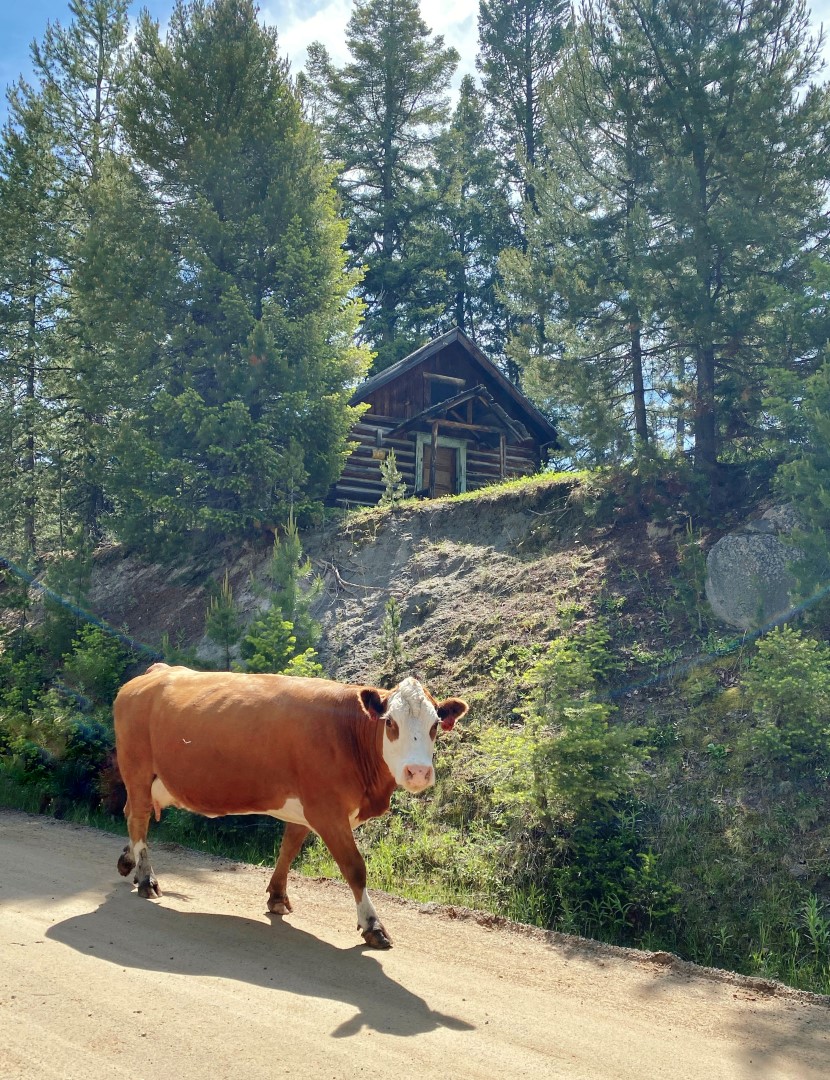 Passing a cow on Garnet Range Road. P. Marlin 2020
Passing a cow on Garnet Range Road. P. Marlin 2020
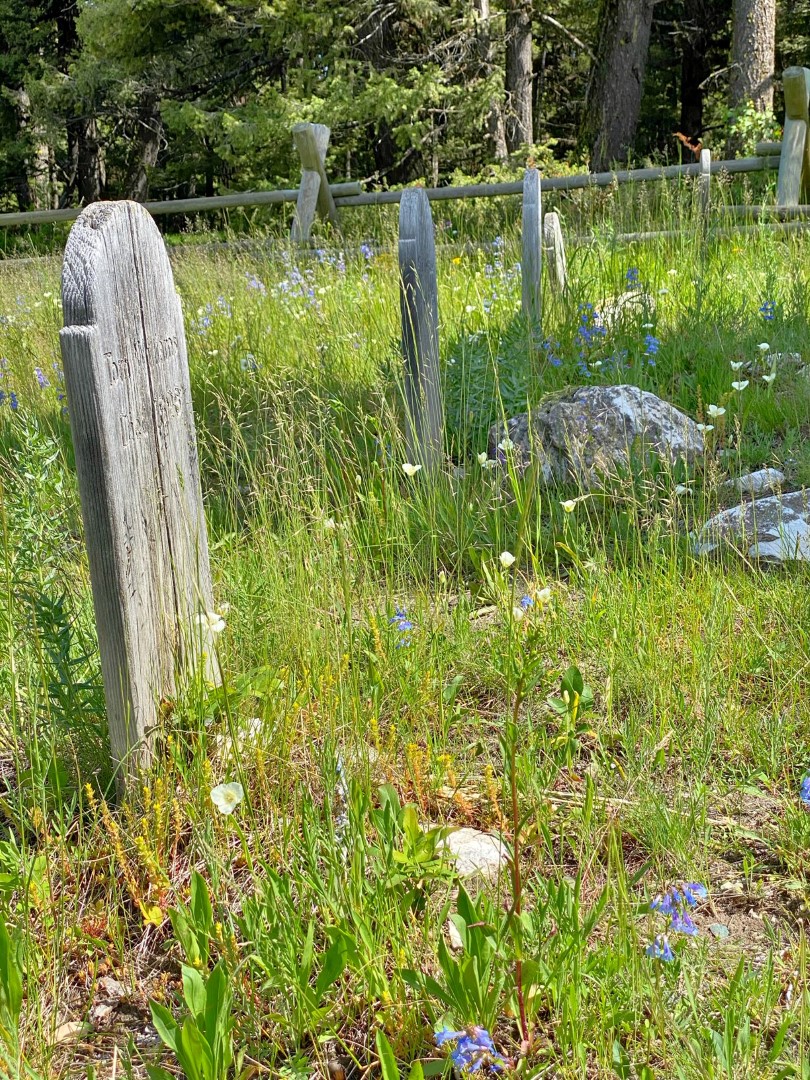 Sand Park Cemetery on the Garnet Range Road. P Marlin 2020.
Sand Park Cemetery on the Garnet Range Road. P Marlin 2020.
 Garnet, Montana. Our Garnet Ghost Town adventure begins. P. Marlin 2020
Garnet, Montana. Our Garnet Ghost Town adventure begins. P. Marlin 2020
Before the discovery of the lode deposits (hard rock mining) in the Garnet mining district, placer deposits (stream/panning) were discovered at Bear Creek in 1865, an area subsequently known as Bearmouth. By 1868, a small mining camp called "Beartown" sprang up near Bear Creek. Beartown had several stores, saloons, gambling houses, a blacksmith shop and other businesses.
Soon after the discoveries at Bearmouth, prospectors began searching the interior of the Garnet Range, named for the semi-precious stone found in the area, for other placer and lode deposits. It was soon realized that the gold that washed down from First Chance Gulch indicated possible rich quartz veins.
Without proper road transport required for lode mining, prospectors, known as "Bear Town Toughs," were dependent on snow melt for placer mining for several years. As proper road construction allowed access to heavy equipment, the transition from placer to lode mining began to take place. 1
As more discoveries were made, a new mining town was hastily built about three miles north of Beartown, at the head of First Chance Creek. It was called Garnet.
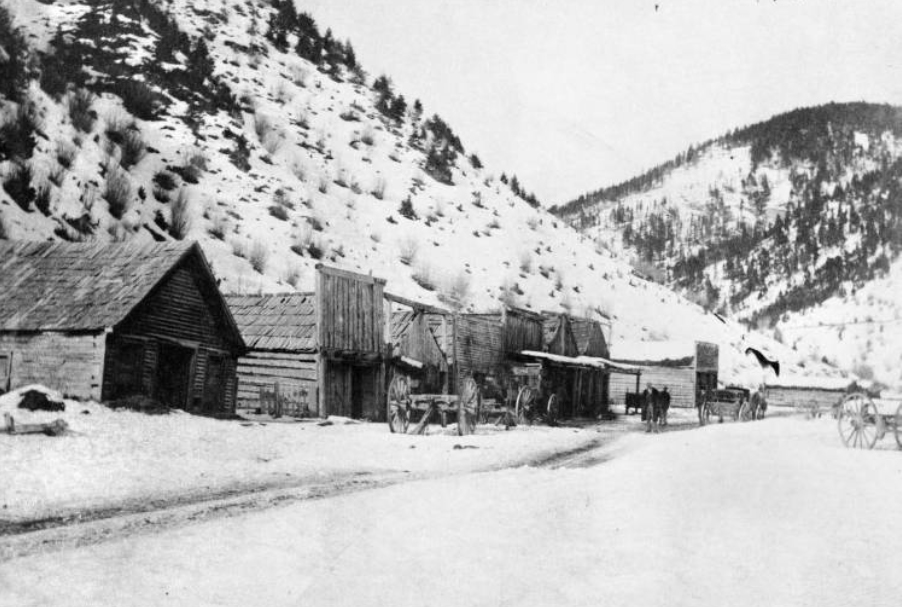 Beartown, Montana. 1880-1900. Montana Memory
Beartown, Montana. 1880-1900. Montana Memory
By the 1870's, placer mining had become less profitable. There were some miners, however, like "old-time placer miner," Samuel Ritchey, who thought the area was rich with gold-bearing quartz and persevered. In 1874, Ritchey came across some "likely-looking rusty quartz"about two miles southwest of Coloma close to First Chance Gulch. He staked at 1500 feet running the claim east and west. Originally from Illinois, Ritchey named the claim "Nancy Hanks" for Abraham Lincoln's mother. 2
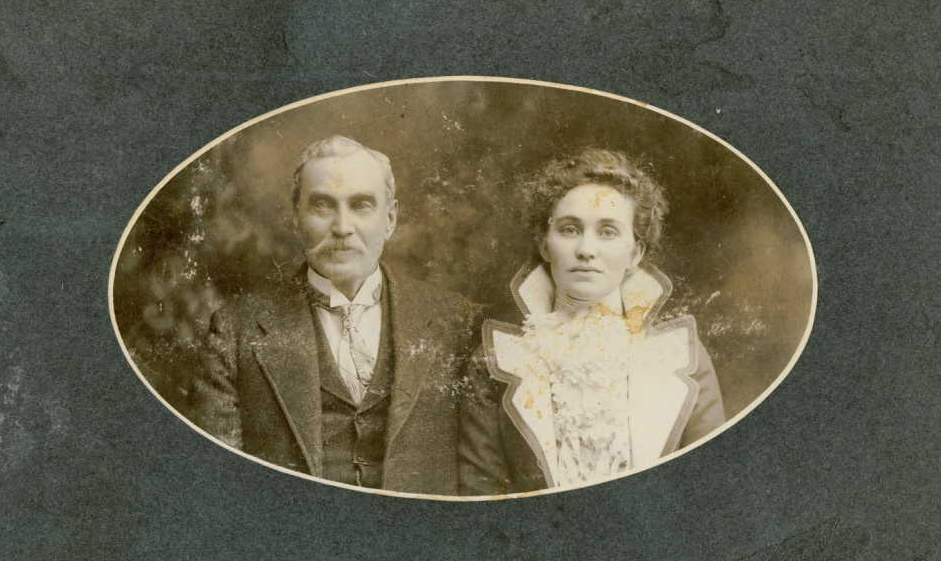 Samuel Ritchey with his wife, Lena Stai. Samuel
married Lena in 1900 when he was 67 and she was 21. They had two
children, a boy and a girl. Samuel died in 1921 at the age of
88. Ancestry. Find A Grave.
Samuel Ritchey with his wife, Lena Stai. Samuel
married Lena in 1900 when he was 67 and she was 21. They had two
children, a boy and a girl. Samuel died in 1921 at the age of
88. Ancestry. Find A Grave.
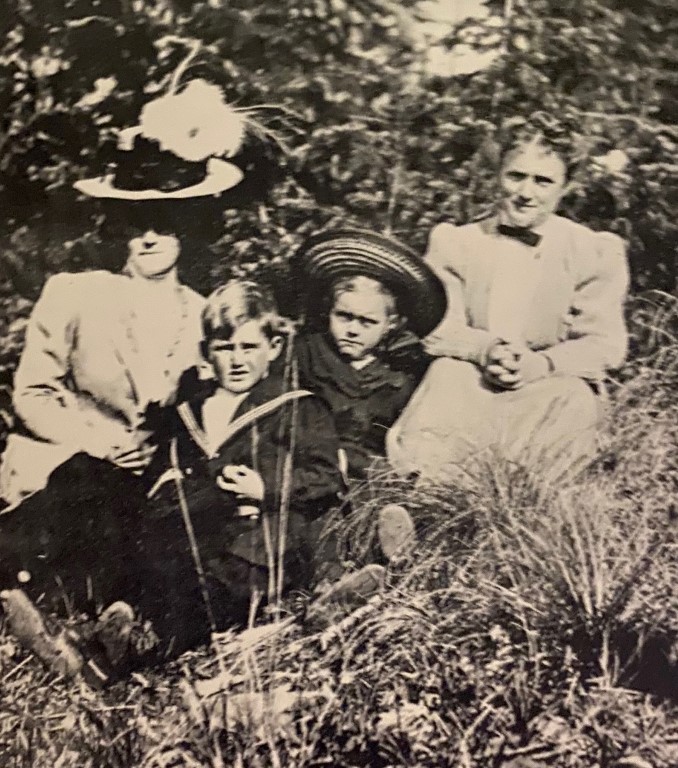 Garnet, Montana. Mrs. Ritchey (left) with her children and Mrs. Samuel Adams. 7
Garnet, Montana. Mrs. Ritchey (left) with her children and Mrs. Samuel Adams. 7
"The Ritchey home was the largest family residence in Garnet. It was two stories, and the main part was built of logs. For all his wealth his house was a rather simple three room affair built with vertical board walls. Flower beds outlined in stone gave it a landscaped appearance. Across the front was a long porch. On the south was a parlor which must have been very elegant in it's day, complete with not only fancy wallpaper, but embossed brass hardware on the doors and even gold picture rail. Off the parlor was a small bedroom, and to the north was a kitchen. A back porch and pantry filled the corner produced by the L shaped house. Even Ritchey made do with stove pipe chimneys, but he did have double hung window which few other houses in Garnet had. Originally the home was furnished with elegant Victorian furniture from eastern factories." 4
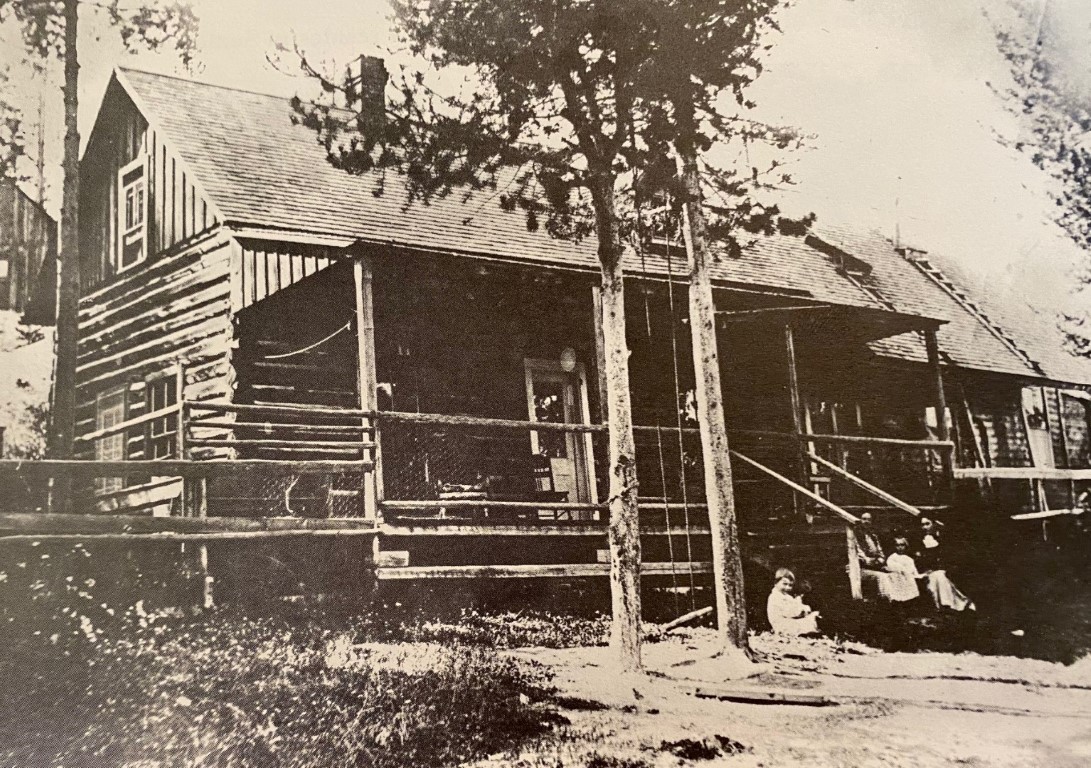 Garnet, Montana. The Ritchey home. 7
Garnet, Montana. The Ritchey home. 7
The Ritchey Hotel, built by Helmut Schoenfield in the early 1900s, was named in honor of Sam Ritchey. Run by D.A. McDonald, E.S. Woods and Helmut Schoenfield, it was known as one of the finest hotels in the area and was thought to have been located near the Nancy Hanks mine.
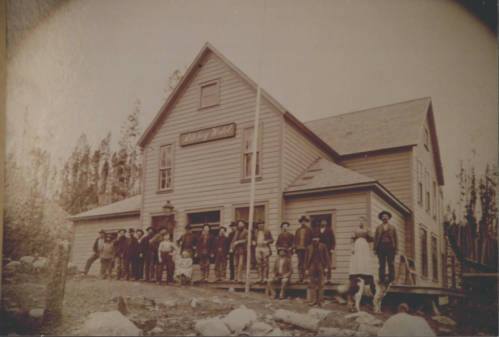 Garnet, Montana. The Ritchey Hotel. Drummond Library.
Garnet, Montana. The Ritchey Hotel. Drummond Library.
By 1880, showings from the Nancy Hanks mine were good enough that other prospectors, like Pete McDermott from Beartown, decided to stake ground to the east of Nancy Hanks, naming it the "North-western." Ritchey claimed further south of the Nancy Hanks mine, and named it "Tiger Lode." Dr. Peter Mussigbrod, a pioneer doctor, had staked "Lead King," "Red Cloud," and "Fourth of July" located near First Chance Gulch. Between 1890 and 1895, 40 lode claims were filed. 2
 Modern map of the Garnet mining district.
Modern map of the Garnet mining district.
In 1896, Sam Ritchey began drilling and blasting the Nancy Hanks mine. "At the time, the deepest working was down 35 feet. They put it down 10 feet further. The two broke into a seam of red, iron-heavy quartz." 2 A rich vein of red ore was found in a shoot off the mine's old shaft. Two crews of 12 men worked around the clock extending the shaft to 100 feet. It was soon evident that the "Nancy Hanks" had a major gold vein. A new gold rush, centered around hard rock mining, was now underway. The Nancy Hanks mine became one of the mainstays of the district for the next three years and then continued to produce intermittently until 1907, at which point it had produced about $300,000.1
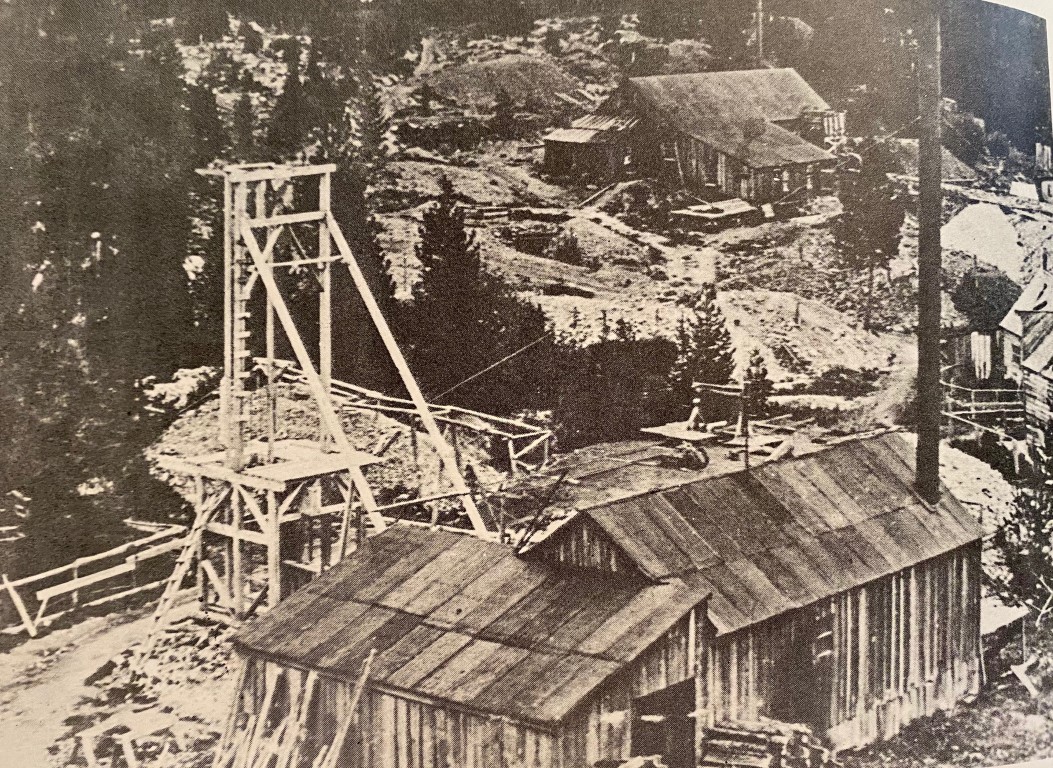 Garnet, Montana. The Nancy Hanks mine. 7
Garnet, Montana. The Nancy Hanks mine. 7
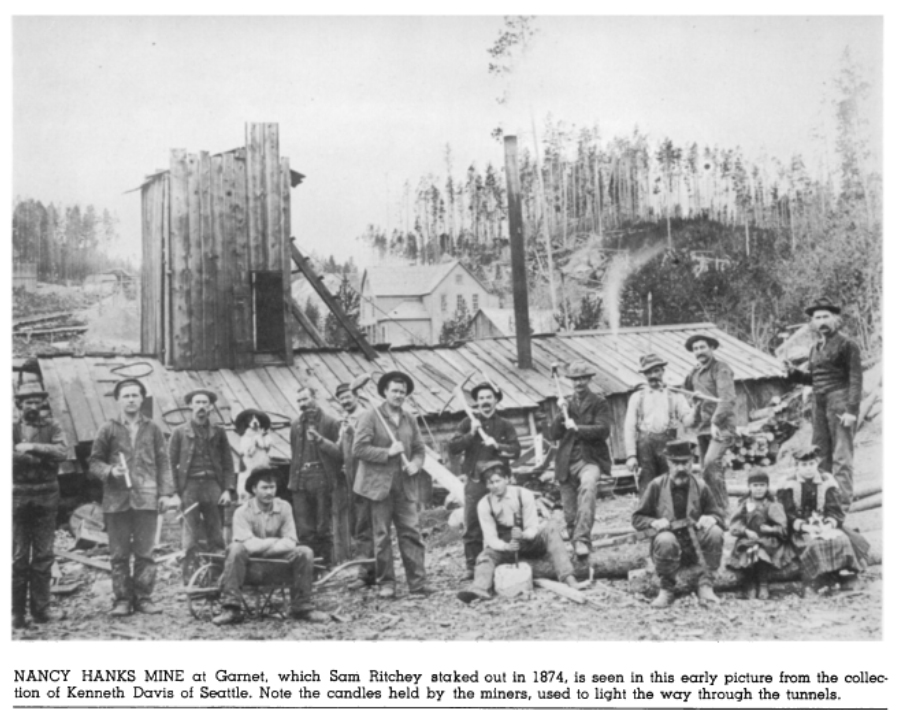
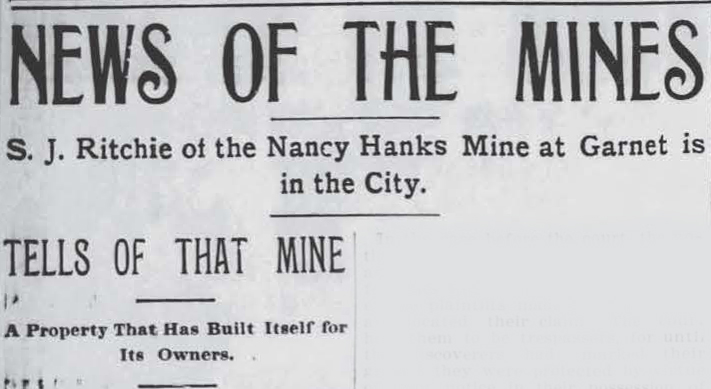 The Butte Miner February 18, 1899.
Full article
The Butte Miner February 18, 1899.
Full article
A year or so before the strike in the Nancy Hanks mine, a local pioneer doctor, Dr. Peter Mussigbrod, built a 10-stamp mill at First Chance Gulch. The mill was managed by A. H. Mitchell, and the surrounding area became known as the town of "Mitchell," though it would eventually be renamed "Garnet." The mill was not successful at first. The equipment, mostly second-hand, had mechanical issues and often broke down. The mill was considered a failure.
By 1897, Mussigbrod improved the mill to where he was able to extract more of the valuables out of the ore than the other mill operators in the area. The improved mill saved 75% of the values in his lower grade ores. Carefully holding the mill tailings for future treatment, Mussigbrod added Wilfley tables (a sand table that separated heavy mineral particles from lighter gangue) which raised his recoveries to a high of 90%. Mine owners began giving their ore to him to process. 2
In the 1900 United States Census, Mussigbrod was boarding at the Crawford Hotel in Garnet.
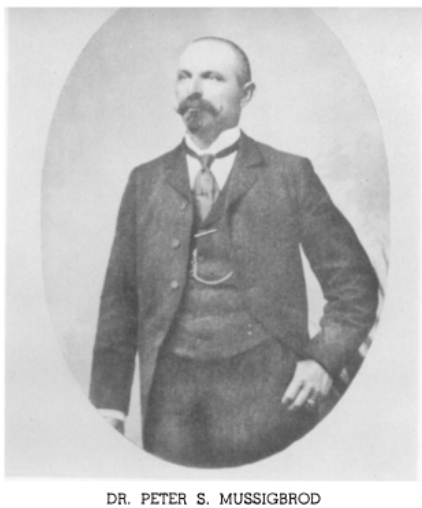 Dr. Peter S. Mussigbrod. 2
Dr. Peter S. Mussigbrod. 2
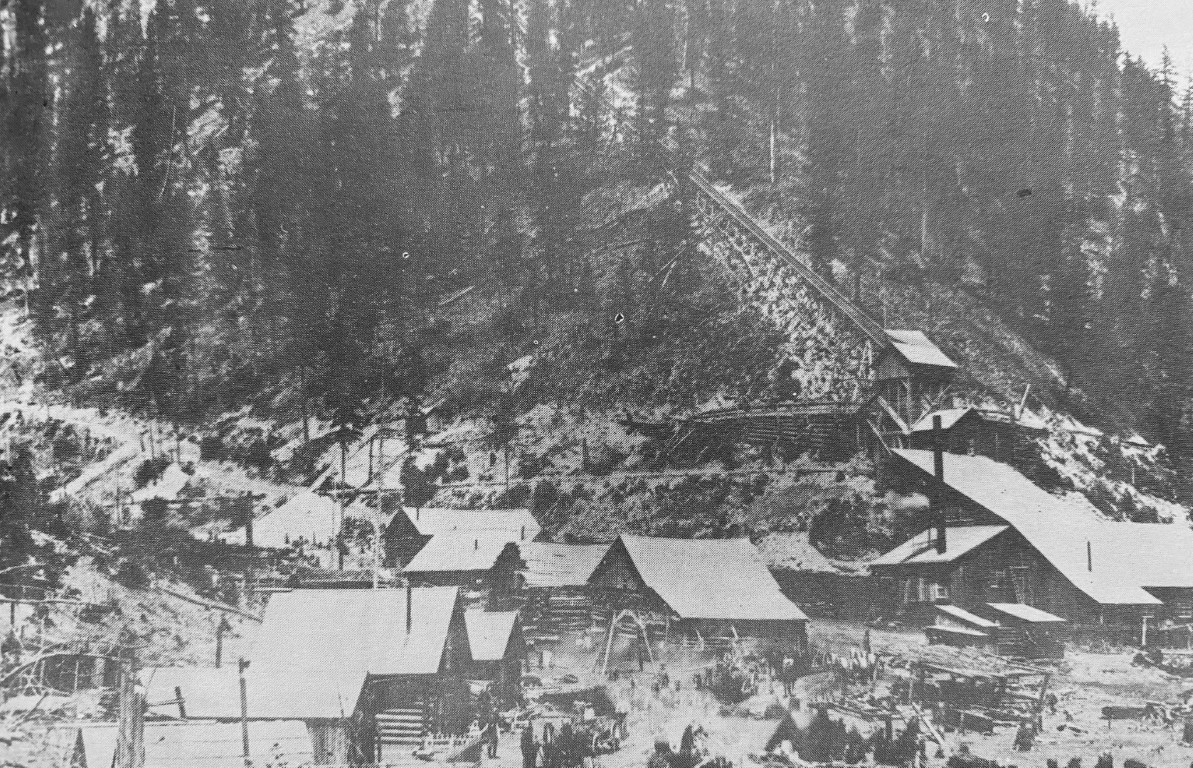 Garnet, Montana. The Mussigbrod Mill. 7
Garnet, Montana. The Mussigbrod Mill. 7
"Either because of the Garnet Range on which it stood, or because of the masses of brown garnet rock derived from the contact of Limestone granodiorite the town was called Garnet." 2
Shortly after the Nancy Hanks strike, eager prospectors arrived and were at work all over the mountain. Miners hastily built stores, hotels, livery stables, saloons and hotels near the head of First Chance Creek. Constructed with only the materials they had available, most buildings did not have foundations, cabins were built with pine and fir logs, and most fireplaces were made of clay which cracked after constant use. Garnet did not have electricity, though the Garnet Hotel installed gas lighting. 2
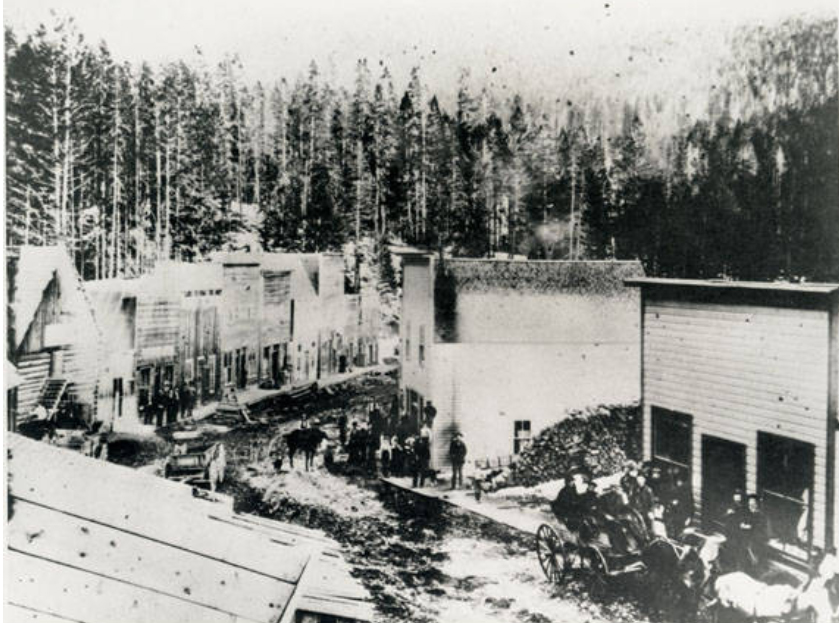 Garnet, Montana. 1905-1906. Montana Memory
Garnet, Montana. 1905-1906. Montana Memory
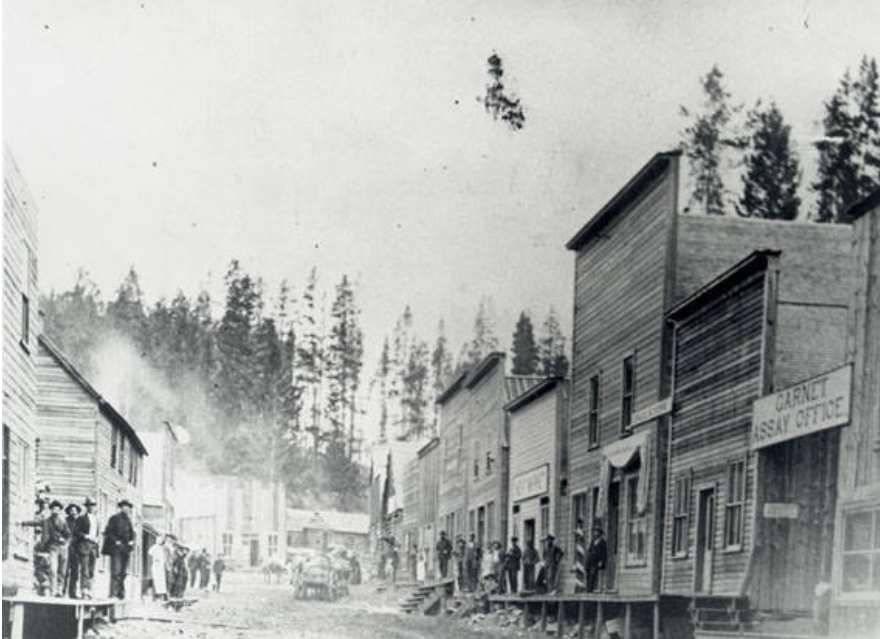 Garnet, Montana 1894-1896.
Montana Memory Project
Garnet, Montana 1894-1896.
Montana Memory Project
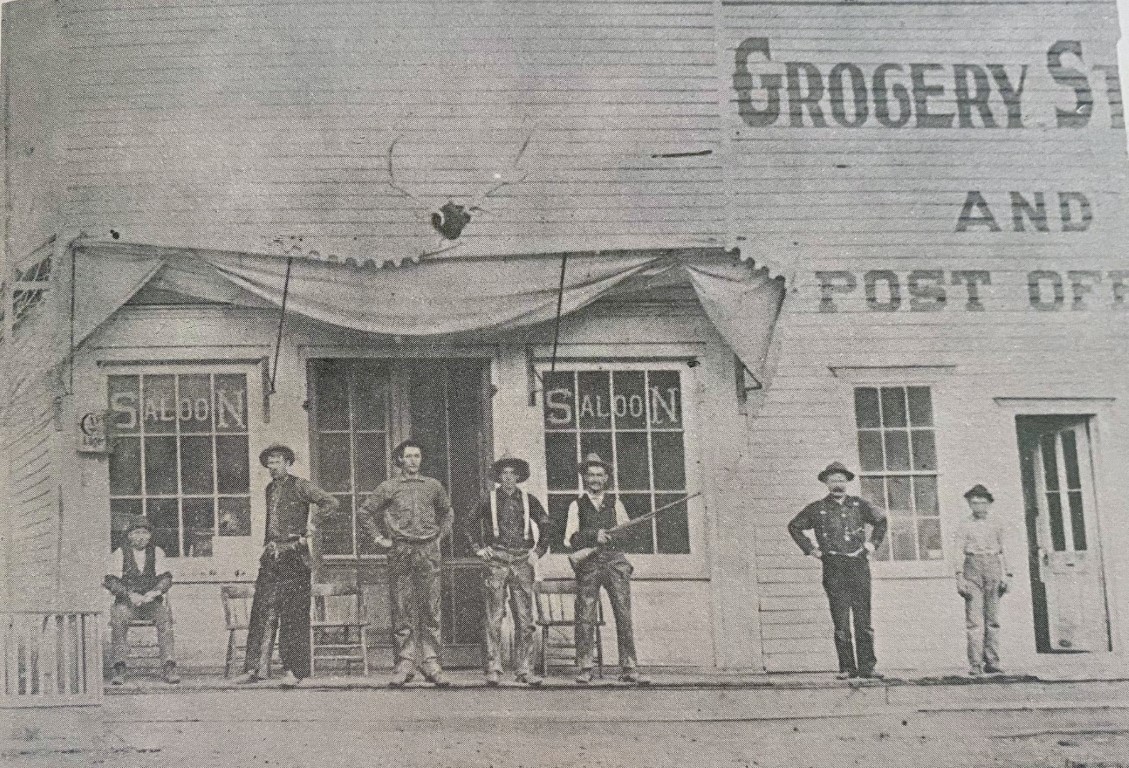 Garnet, Montana. Saloon, grocery store and Post Office. 7
Garnet, Montana. Saloon, grocery store and Post Office. 7
Referencing the article below, Frank Murray, an old prospector, recalls Christmases in Garnet with plenty of drinking, drilling contests, and shooting matches. "Christmases when Garnet was a live camp, when there were 11 saloons and 50 dancing girls in the place, when gold dust was the only legal tender and when Whiskey was four bits a shot. Once in a while a man was killed, usually from falling off a horse when drunk."
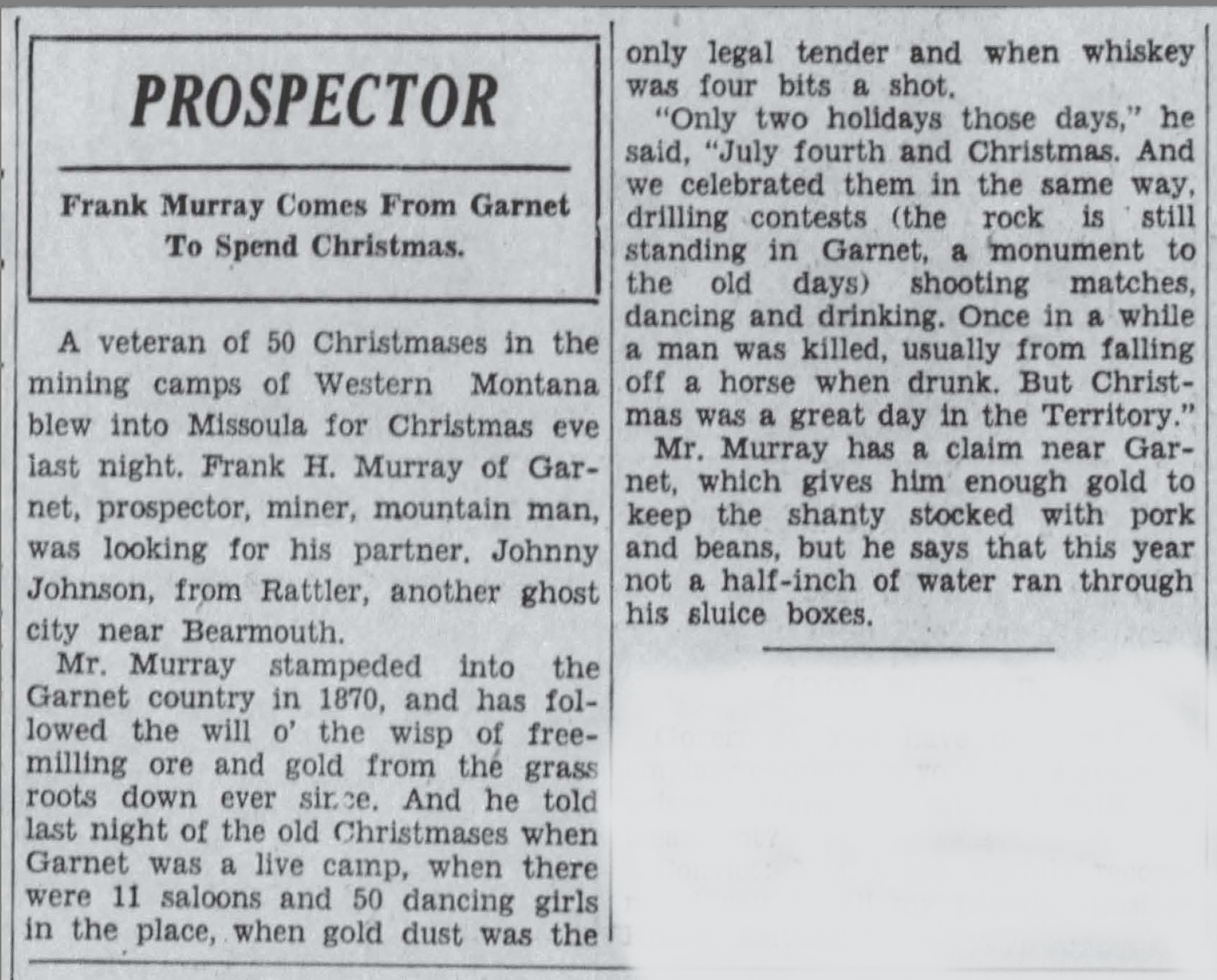 Garnet, Montana. One miner tells the story of a typical Garnet Christmas.
Garnet, Montana. One miner tells the story of a typical Garnet Christmas.
By 1900, gold prospects began to wane. Many of the veins disappeared and deeper shafts made gold recovery difficult and expensive. The original miners who had profited from the original strike now leased their mines to others. By 1905, many mines were abandoned. In 1912 a devastating fire destroyed many buildings in the business district.
 Garnet, Montana. 1912 Fire.
Read full article.
Garnet, Montana. 1912 Fire.
Read full article.
At the onset of World War I in 1914, many of the residents left Garnet for defense-related jobs. Davey's General Store and the Well's Hotel remained open, however, many of the cabins, as well as the furniture in them, were abandoned.
When President Franklin D. Roosevelt raised gold prices in 1934, Garnet was again revived. A new wave of miners moved into the abandoned cabins and began re-working mines and dumps. The town grew to about 250 residents. During this time, new cabins were built.
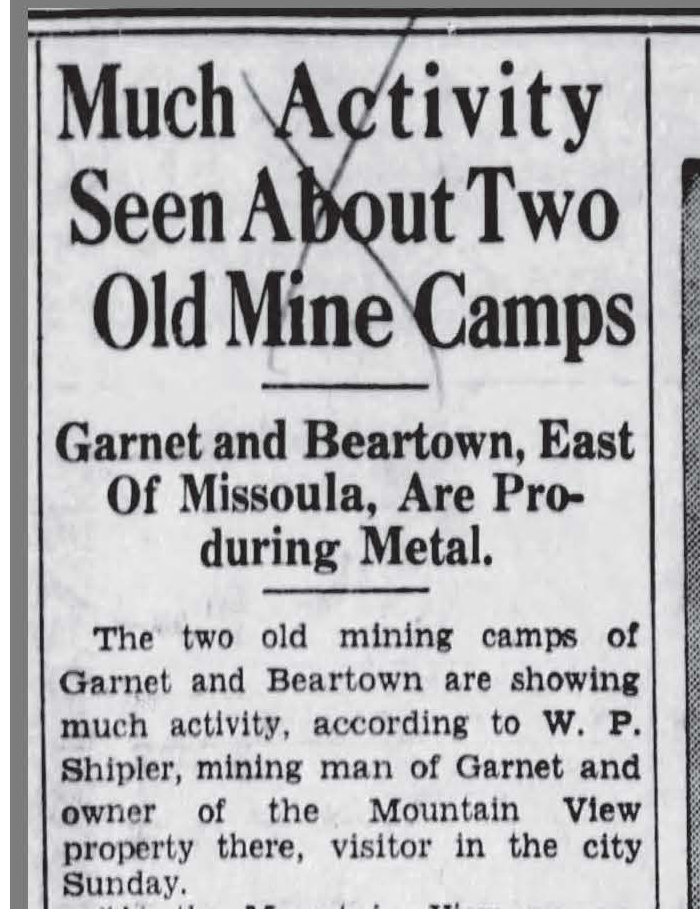 Garnet, Montana. A renewed interest in mining in 1938.
Garnet, Montana. A renewed interest in mining in 1938.
Garnet was again affected by war when the United States entered World War II. Wartime restrictions on dynamite made mining impossible. Only a few residents were left, including Frank Davey, the owner of Davey's Mercantile. After his death in 1947, his store's contents were auctioned off. In 1942, the post office closed for good.
While men dominated Montana’s earlier mining camps, Garnet miners brought their families. A school served forty-one students. Dances, hay rides, quilting bees, sewing circles, and picnics provided family oriented social activities. Garnet supported numerous saloons, but its family emphasis tempered usual mining camp vices.
 Garnet, Montana. Residential living in Garnet, one cabin's view
of another. P. Marlin 2020
Garnet, Montana. Residential living in Garnet, one cabin's view
of another. P. Marlin 2020
 Garnet, Montana. Remnants of cloth-backed wallpaper. P Marlin 2020
Garnet, Montana. Remnants of cloth-backed wallpaper. P Marlin 2020
 Garnet, Montana. Clothing and old stove. P Marlin 2020.
Garnet, Montana. Clothing and old stove. P Marlin 2020.
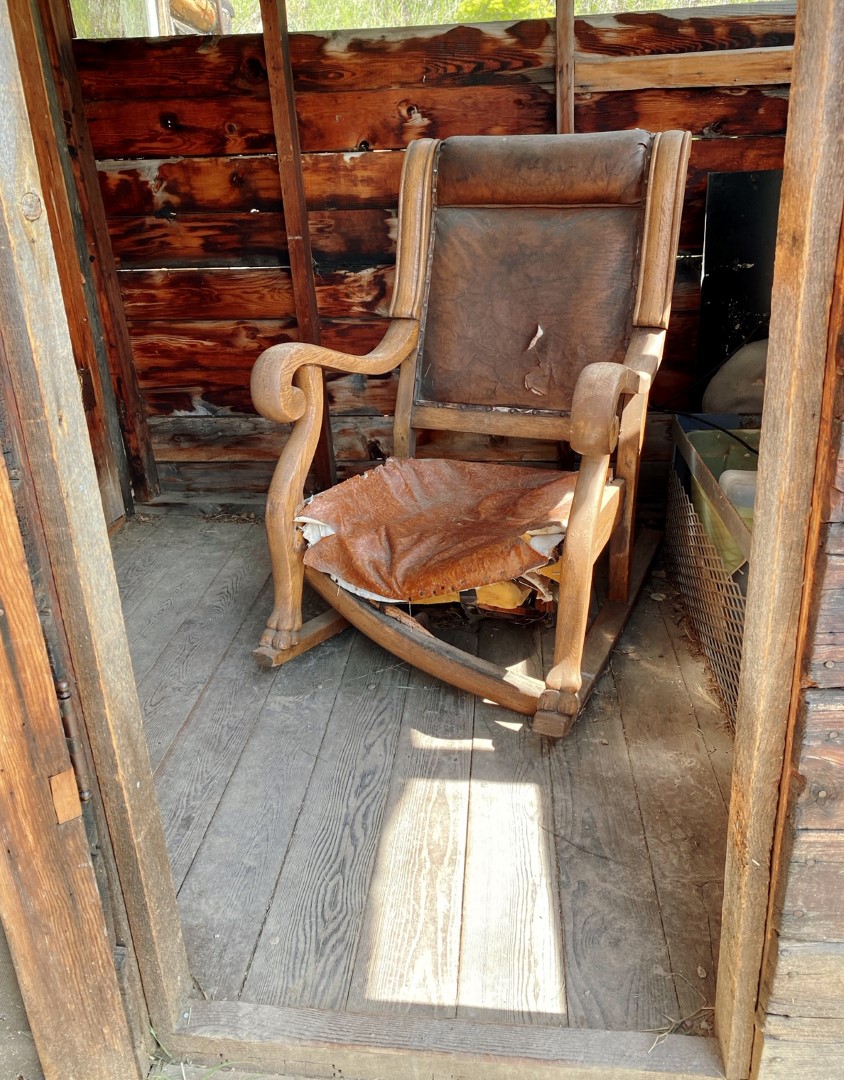 Garnet, Montana. P. Marlin 2020
Garnet, Montana. P. Marlin 2020
Davey's Store opened around 1898 as one of Garnet's first stores. Owned by Frank Davey, the store sold dry goods, clothing, jewelry, mining tools and cuts of meat. It also had a hardware section, a post office for a time, and an office that weighed gold. The meat was stored in the icehouse which also contained a secret compartments built into the back wall which held gold until it could be safely shipped down the hill. An annex was added to the east part of the store to keep flour and sugar. 5
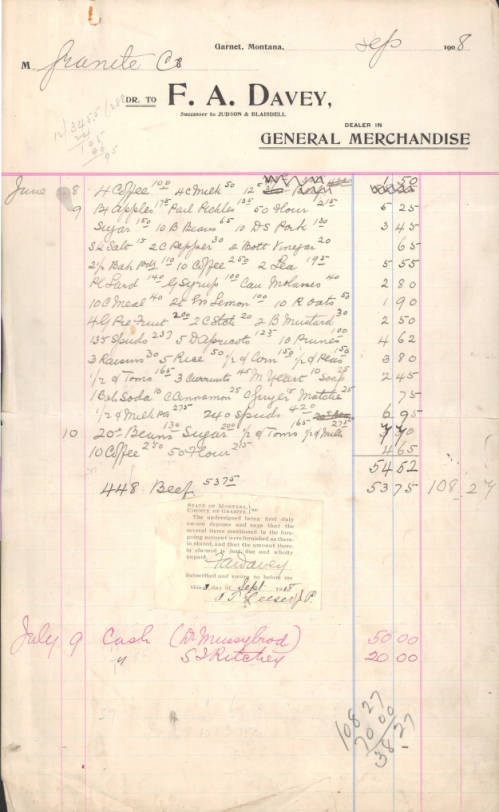 Garnet, Montana. Receipt from Frank Davey's store.
Montana Memory
Garnet, Montana. Receipt from Frank Davey's store.
Montana Memory
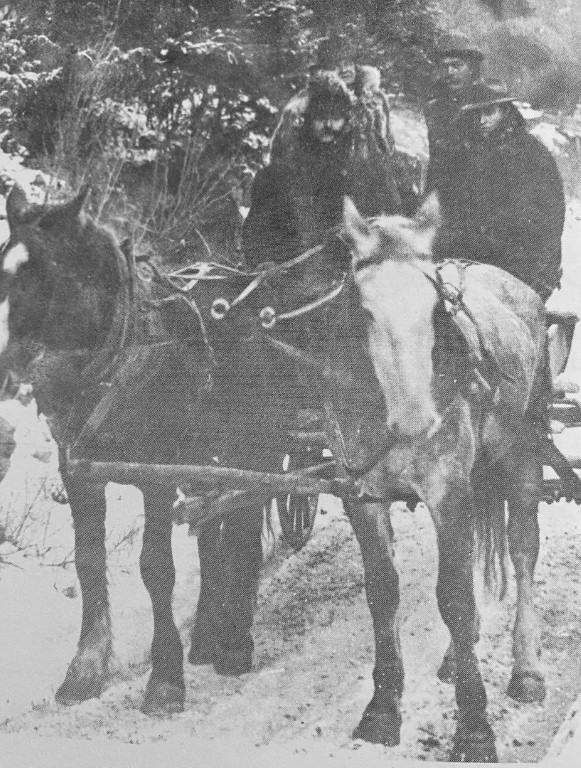 Garnet, Montana. Garnet stage. 7
Garnet, Montana. Garnet stage. 7
In addition to the General Store, Frank Davey owned and operated the Garnet Stage line, a hotel, a mining claim, and a blacksmith shop. Frank always wore a buffalo robe when he drove the stage and was known to have an ample supply of buffalo robes available to keep the women passengers warm on their ascent into the Garnet range. At the time of Davey's death in 1947, he owned the entire town. By 1948, the majority of his leftover store merchandise, personal belongings, and mining claims were auctioned. His Garnet Lode claim, which consisted of most of the land where the town had been built, was donated to the United States Government by Davey’s heirs.
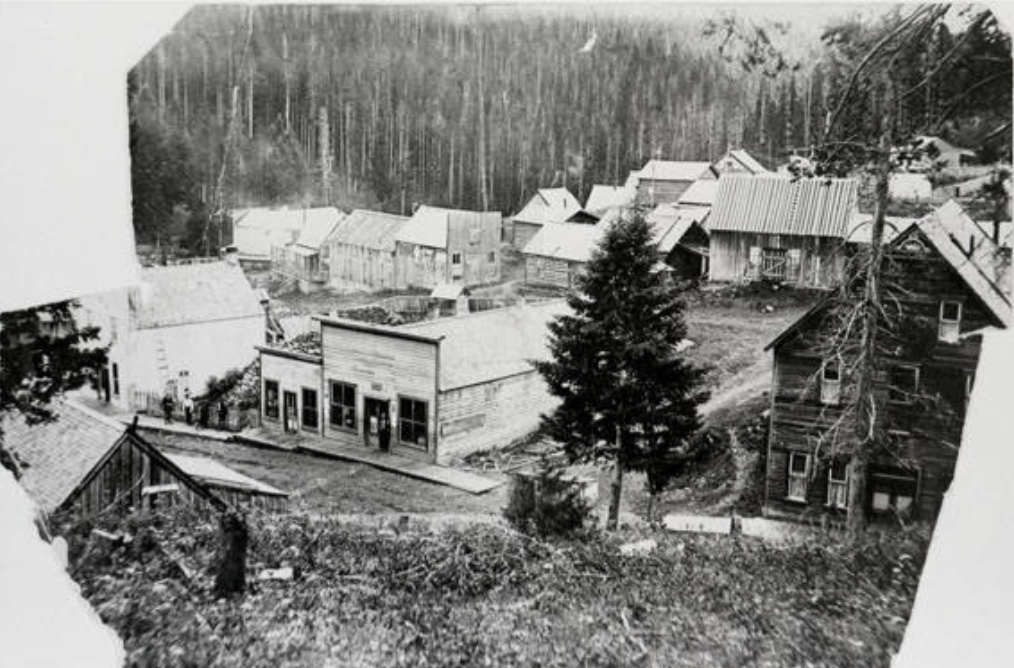 Garnet, Montana. The building in the center of the photo was Davey's Store, and the large three-story building to the right was Wells Hotel.
Montana Memory Project
Garnet, Montana. The building in the center of the photo was Davey's Store, and the large three-story building to the right was Wells Hotel.
Montana Memory Project
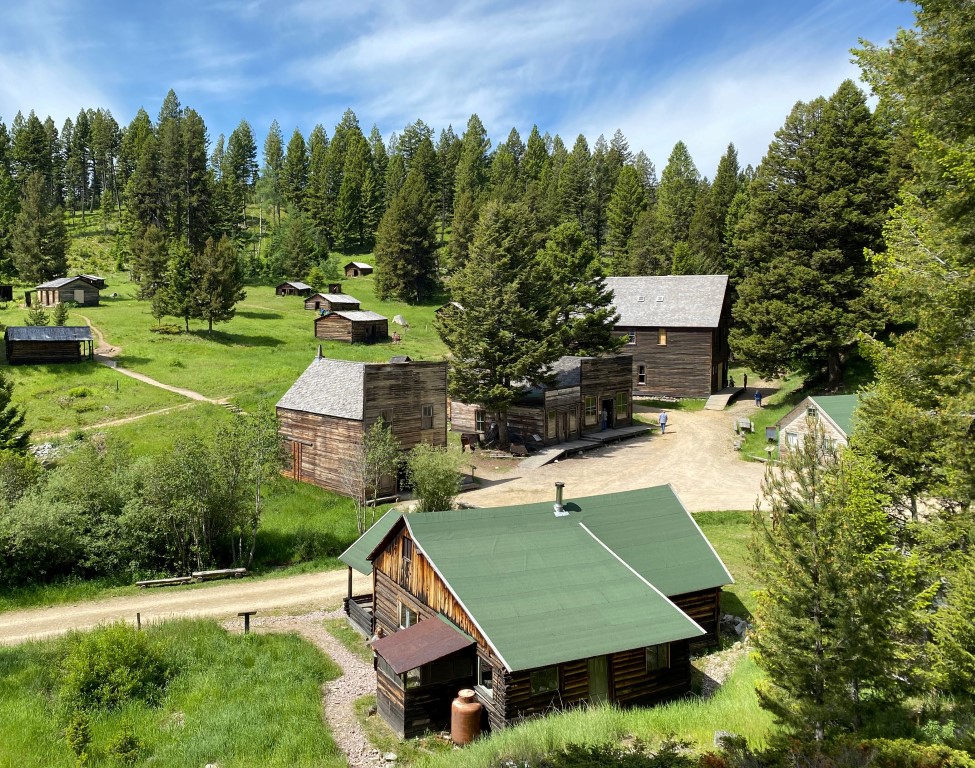 Garnet, Montana. Davey's Store and Well's Hotel can
be seen on the right. P Marlin 2020
Garnet, Montana. Davey's Store and Well's Hotel can
be seen on the right. P Marlin 2020
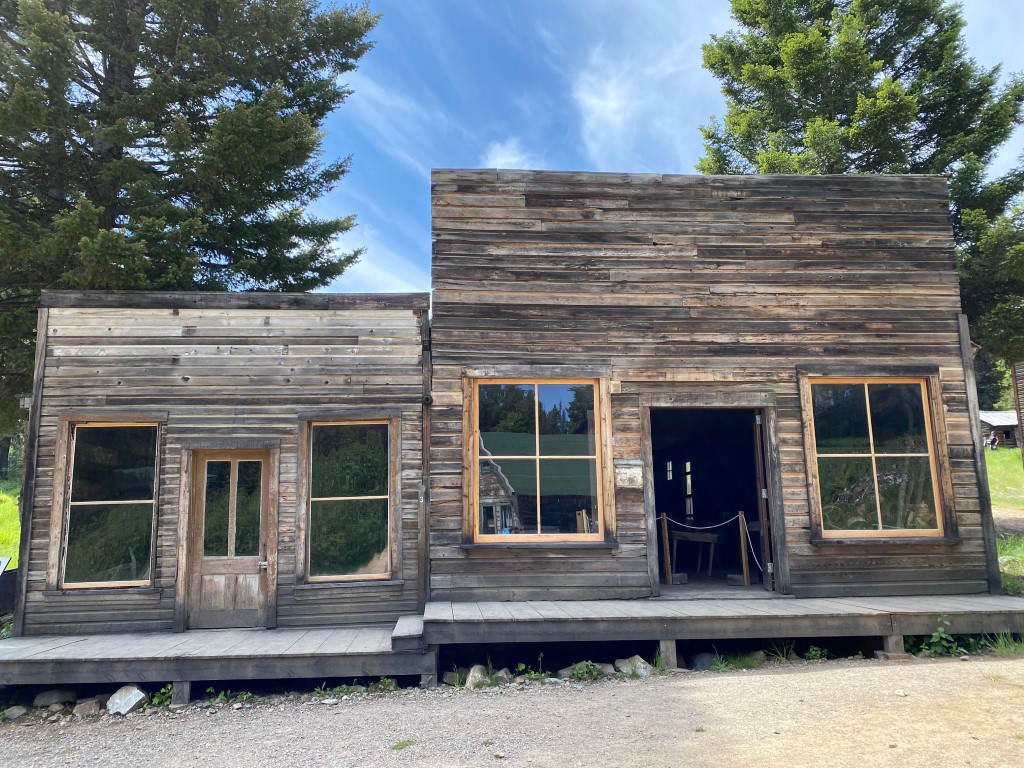 Garnet, Montana. Davey's Store. P. Marlin 2020
Garnet, Montana. Davey's Store. P. Marlin 2020
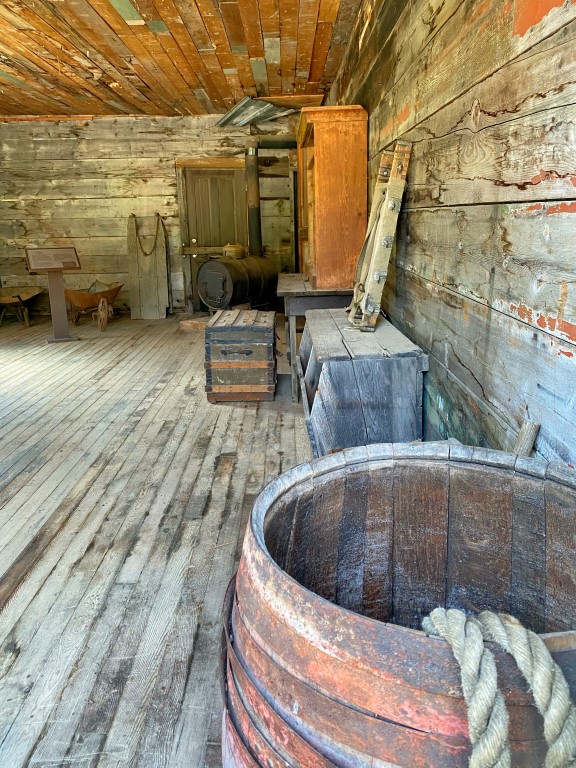 Garnet, Montana. Inside Davey's Store. P. Marlin 2020
Garnet, Montana. Inside Davey's Store. P. Marlin 2020
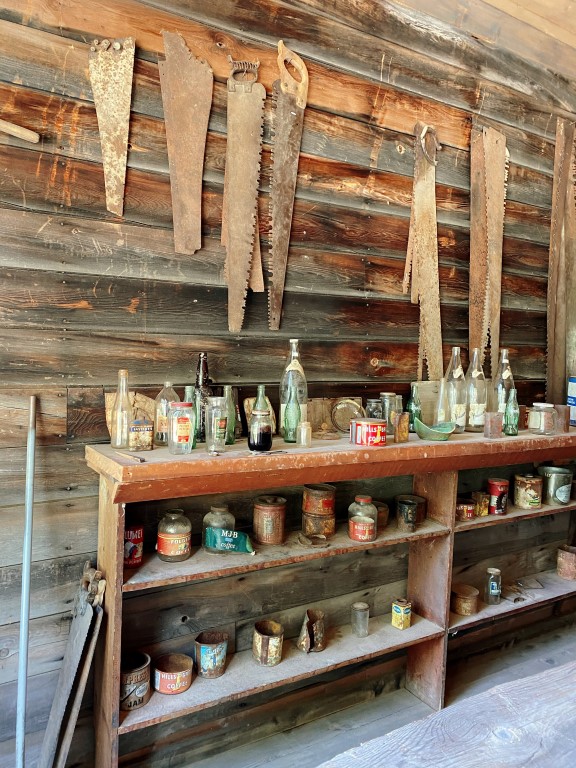 Garnet, Montana. Inside Davey's Store. P. Marlin 2020
Garnet, Montana. Inside Davey's Store. P. Marlin 2020
The J.K. Wells Family came to Garnet from Bearmouth where they had owned a hotel. Mrs. Wells designed both the hotels and had brought in a carpenter to build them. The hotels were quite luxurious for hotels in a rough mining town. 6
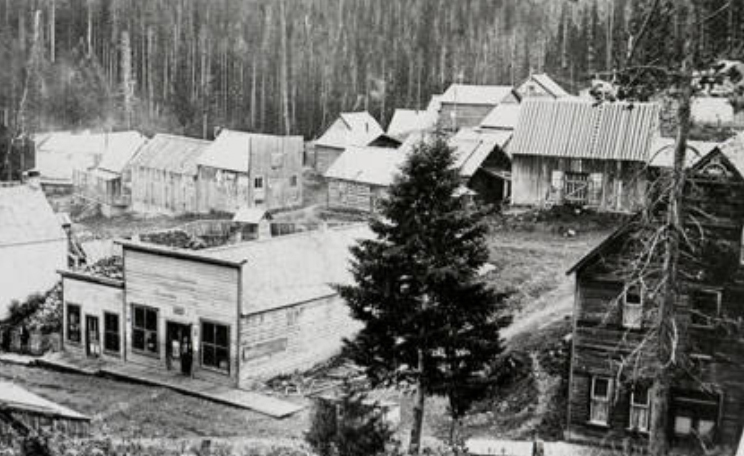 Garnet, Montana. The building in the center of the photo was Davey's Store, and the large two-story building to the right was Wells Hotel.
Montana Memory Project
Garnet, Montana. The building in the center of the photo was Davey's Store, and the large two-story building to the right was Wells Hotel.
Montana Memory Project
The J.K. Wells Hotel was built in the winter of 1897 and was the most impressive building in Garnet. Mrs. Wells designed it after a hotel she owned in Bearmouth. It was quite luxurious in its time, with stained glassed windows and beautifully carved doors. There was also a parlor and a grand dining room. Garnet events, such as the Grande Masquerade, the Hard Times Ball, and the St. Patrick's Day Calico ball were held here.3
There were no plaster walls or insulation at the Wells Hotel. The walls were covered with cloth-backed wallpaper. Upstairs rooms were heated by rising warm air. Miners who could not afford a room, rented floor space on the third floor. The outhouse was behind the hotel and could be reached by descending a few steps from the second floor.
After the Wells Hotel closed in the 1930's, Frank Davey moved into the Wells Hotel kitchen.
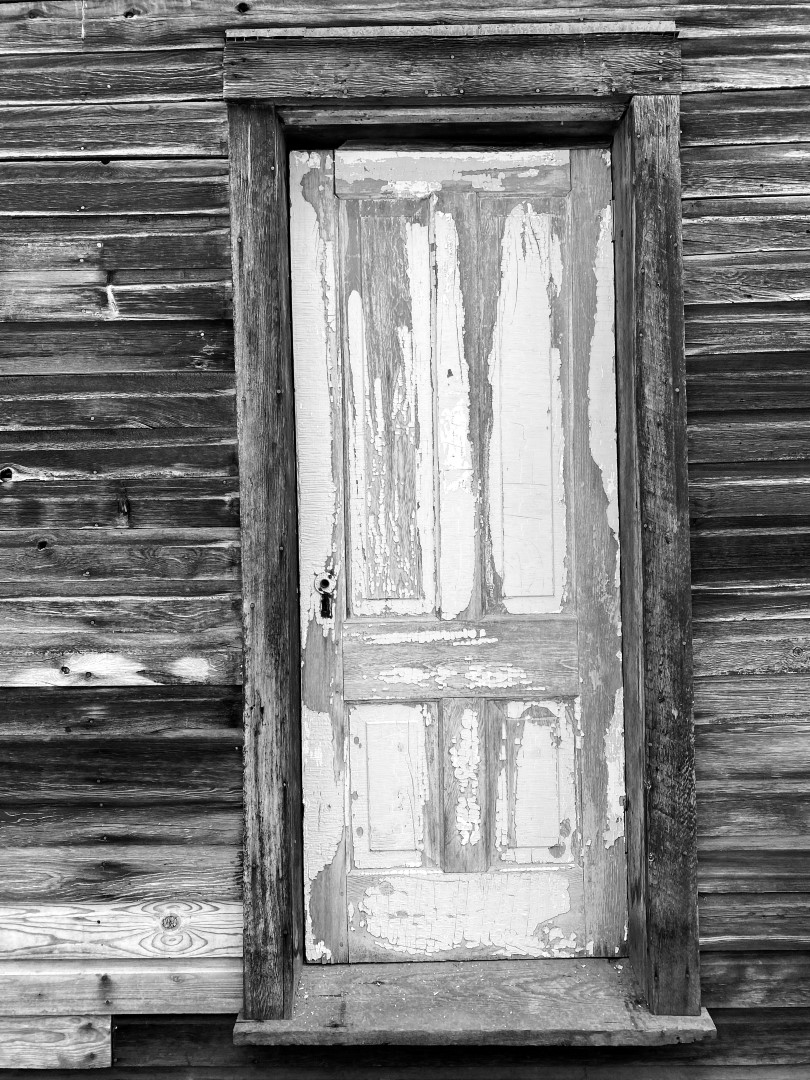 Garnet, Montana. Side entryway at Wells Hotel. P. Marlin 2020
Garnet, Montana. Side entryway at Wells Hotel. P. Marlin 2020
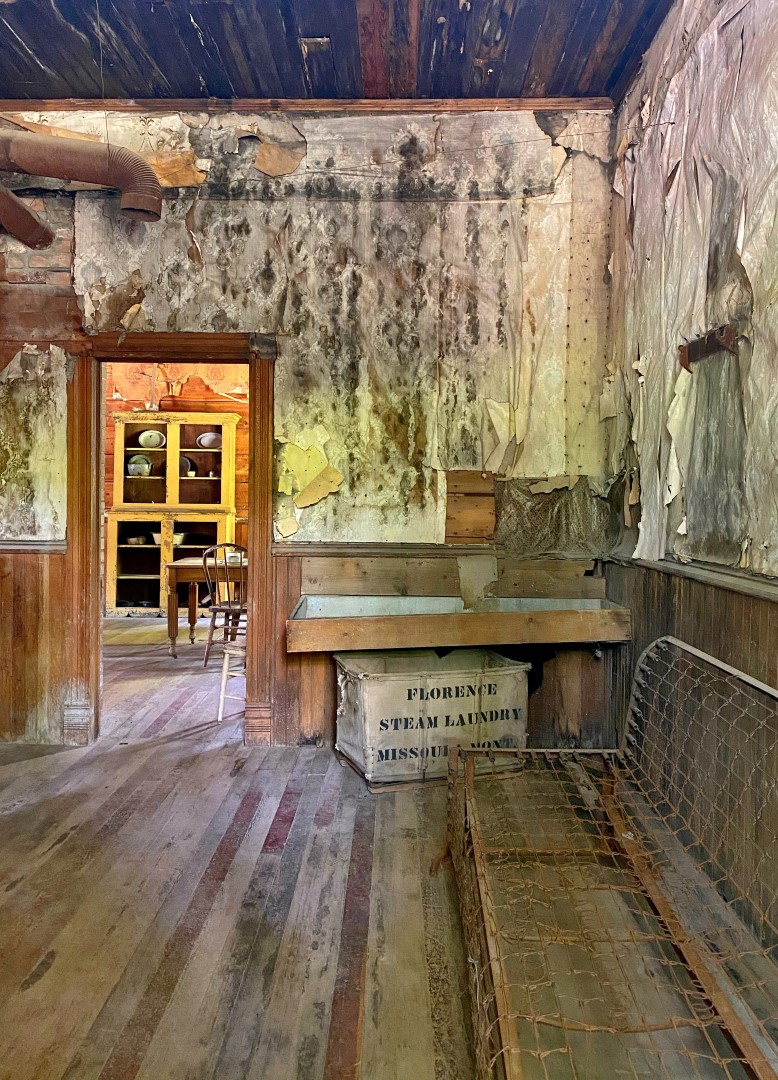 Garnet, Montana. Inside Wells Hotel. P. Marlin 2020
Garnet, Montana. Inside Wells Hotel. P. Marlin 2020
 Garnet, Montana. Inside the Wells Hotel. P. Marlin 2020
Garnet, Montana. Inside the Wells Hotel. P. Marlin 2020
 Garnet, Montana. Inside the Wells Hotel. P. Marlin 2020
Garnet, Montana. Inside the Wells Hotel. P. Marlin 2020
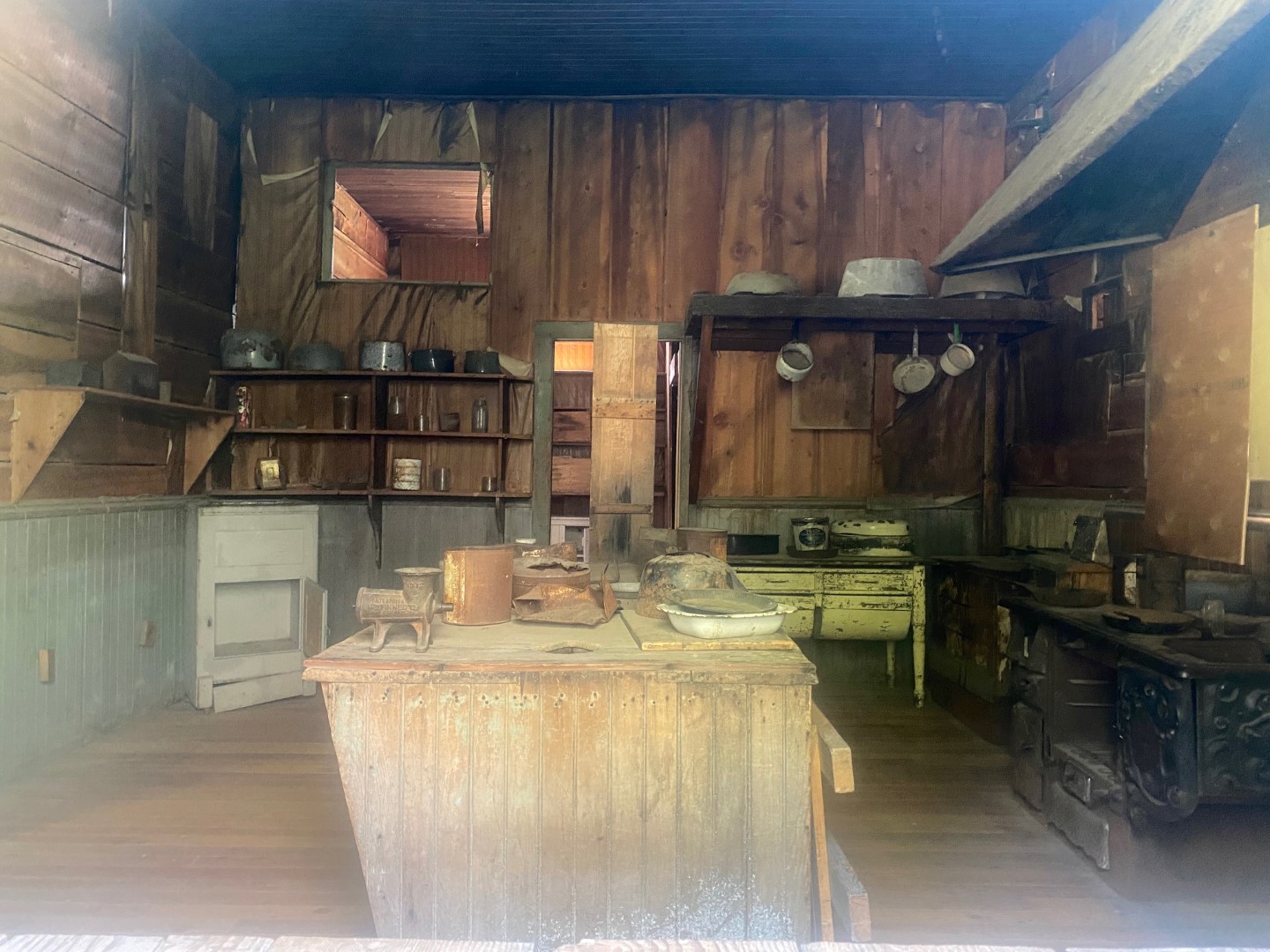 Garnet, Montana. Inside the Wells Hotel. P. Marlin 2020
Garnet, Montana. Inside the Wells Hotel. P. Marlin 2020
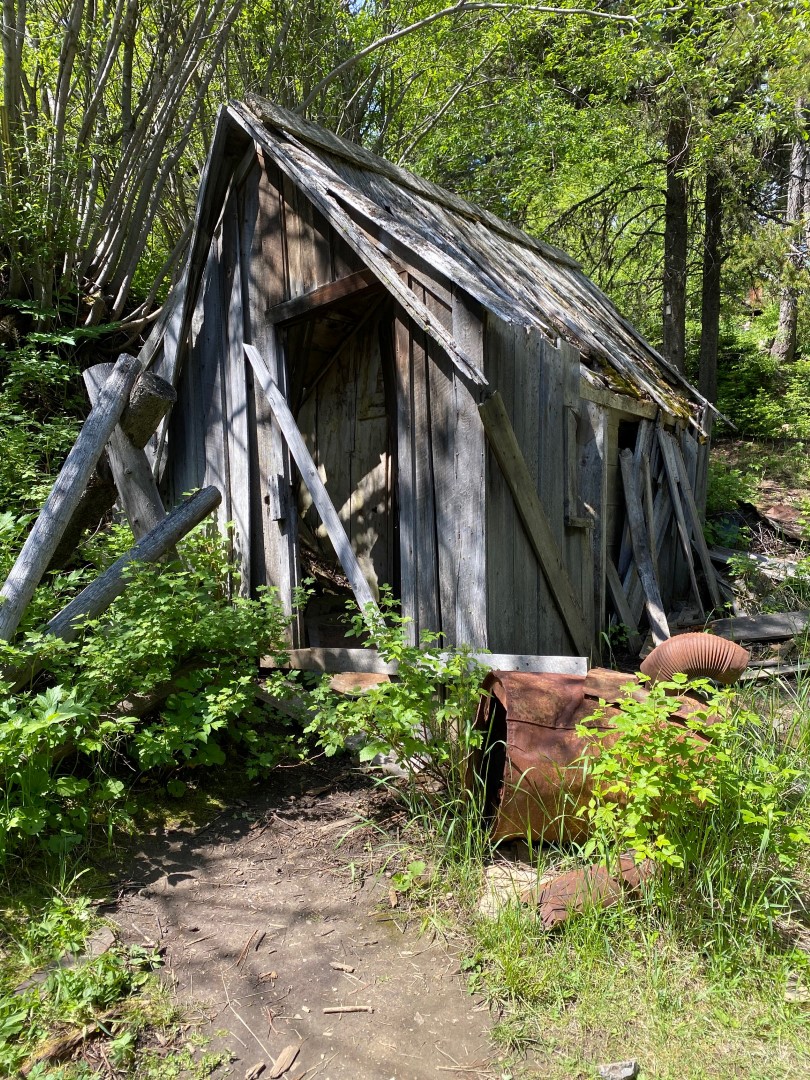 Garnet, Montana. Well's Hotel outhouse. P. Marlin 2020
Garnet, Montana. Well's Hotel outhouse. P. Marlin 2020
Kelley's Saloon is a two story frame building built before 1898. The owner at the time was Robert Moore, and it was called the "Bob Moore Saloon." In 1898, Louis P. Kelley purchased the saloon for $1500. Part interest in the business was sold to Thomas Fraser, and it became known as the "Kelley and Fraser Saloon." Though the Fraser interested in the saloon was sold in 1908, Kelley continued to operate the saloon.
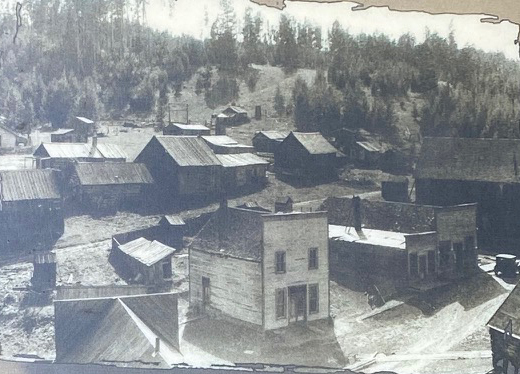 Garnet, Montana. Kelley's Saloon in the middle of the photo with Davey's store to the right.
Garnet, Montana. Kelley's Saloon in the middle of the photo with Davey's store to the right.
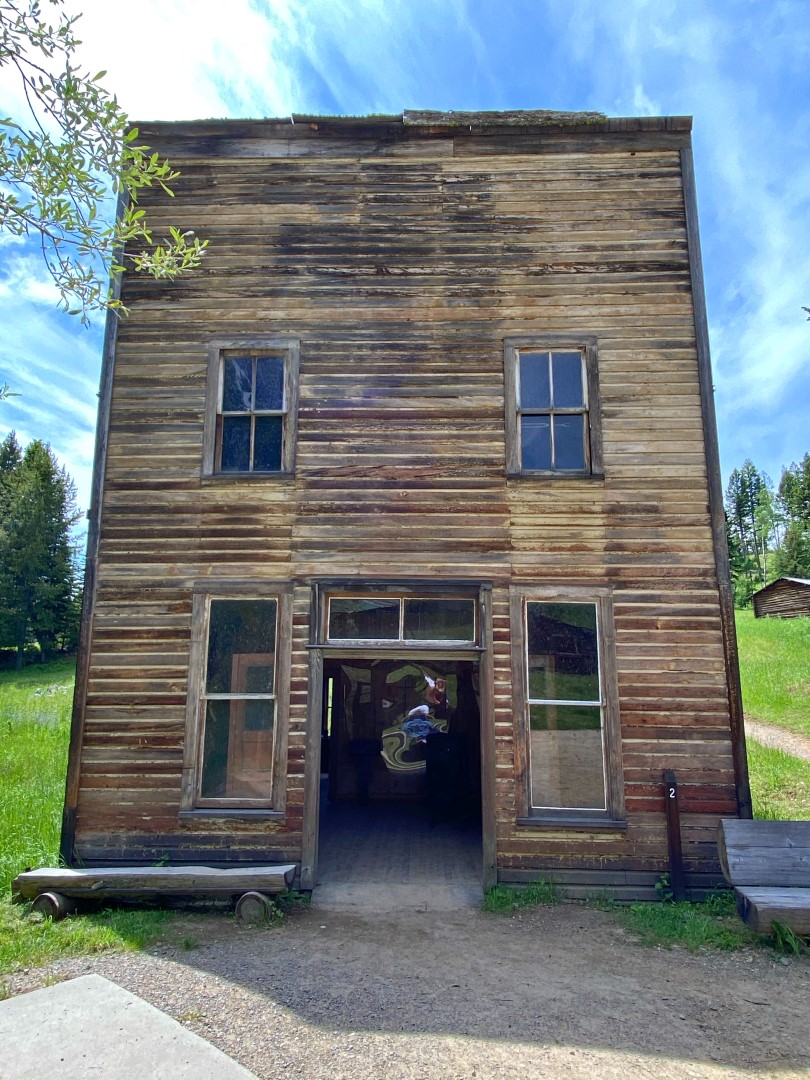 Garnet, Montana. Kelley's Saloon today.
P. Marlin 2020
Garnet, Montana. Kelley's Saloon today.
P. Marlin 2020
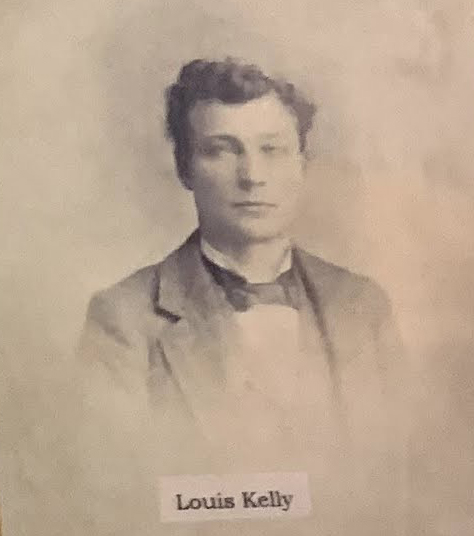 Garnet, Montana. Louis Kelley, proprietor.
Garnet, Montana. Louis Kelley, proprietor.
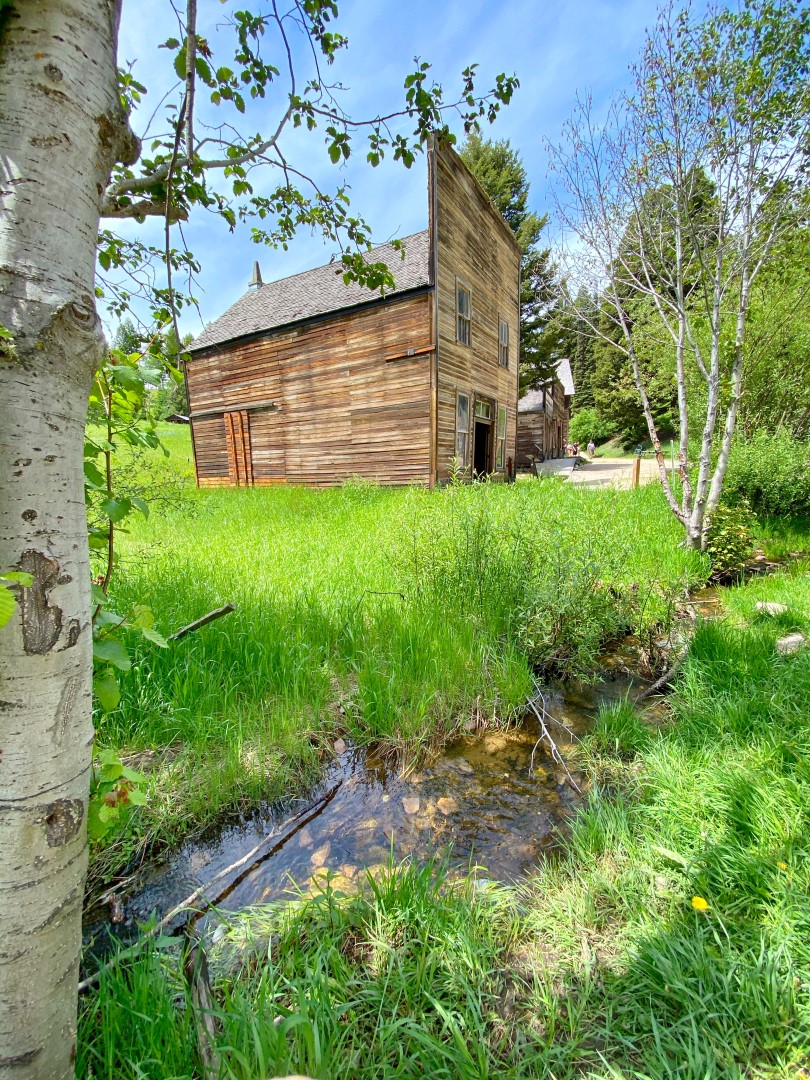 Garnet, Montana. Kelley's Saloon with Davey's Mercantile and Wells
Hotel barely visible in the distance.
P. Marlin 2020
Garnet, Montana. Kelley's Saloon with Davey's Mercantile and Wells
Hotel barely visible in the distance.
P. Marlin 2020
 Garnet, Montana. Kelley's Saloon with Davey's Mercantile to the
right. P. Marlin 2020
Garnet, Montana. Kelley's Saloon with Davey's Mercantile to the
right. P. Marlin 2020
 Garnet, Montana. Newspaper wallpaper inside Kelly's Saloon. P. Marlin 2020
Garnet, Montana. Newspaper wallpaper inside Kelly's Saloon. P. Marlin 2020
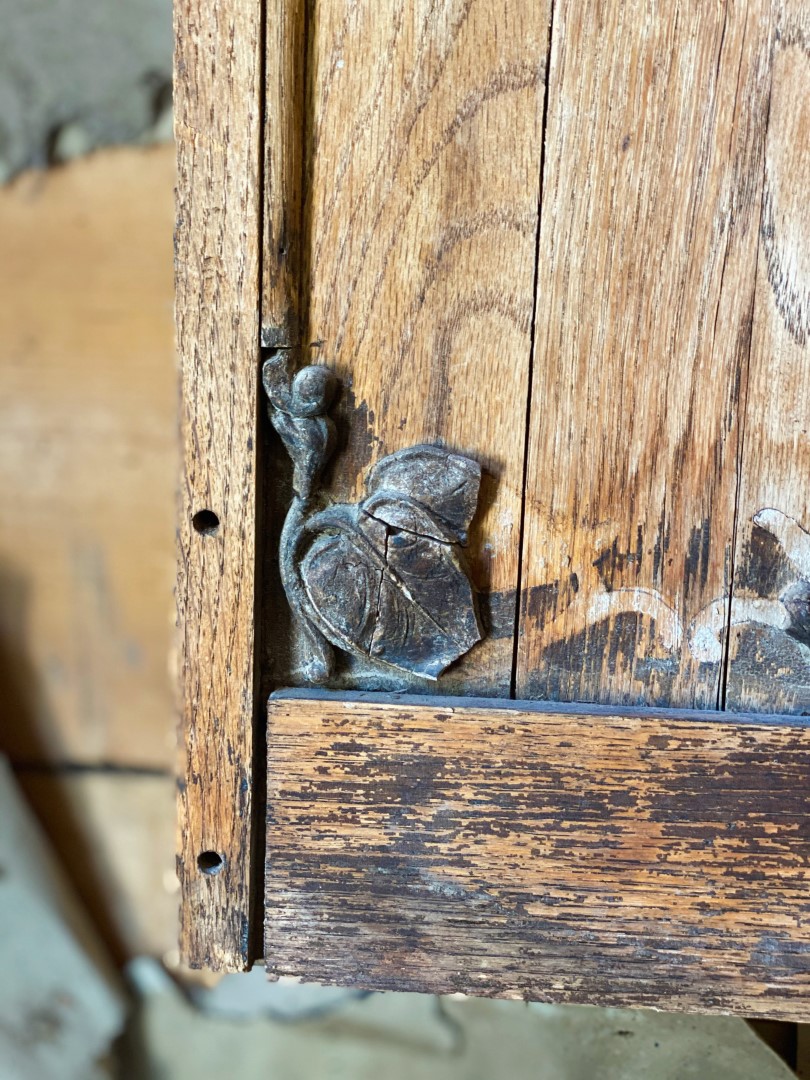 Garnet, Montana. Inside Kelley's Saloon. P. Marlin 2020
Garnet, Montana. Inside Kelley's Saloon. P. Marlin 2020
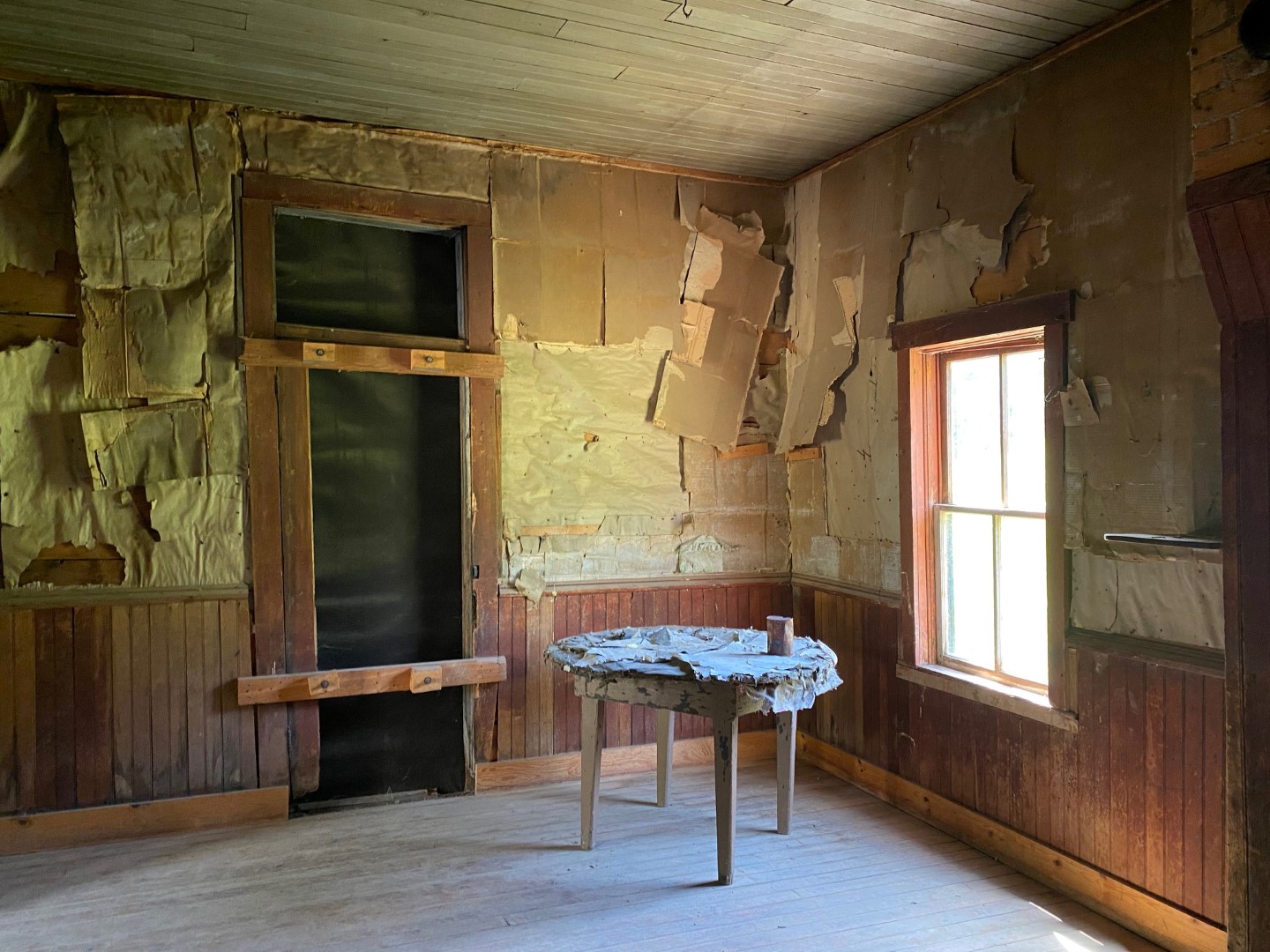 Garnet, Montana. Inside Kelley's Saloon. P. Marlin 2020
Garnet, Montana. Inside Kelley's Saloon. P. Marlin 2020
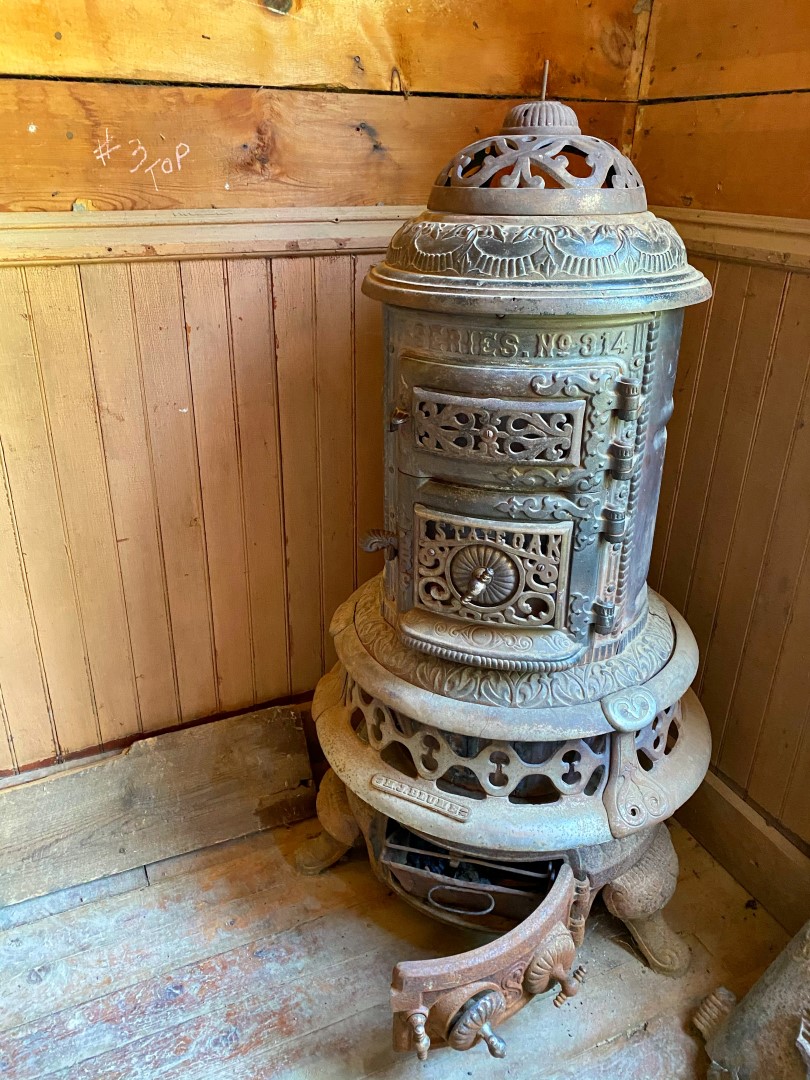 Garnet, Montana. Inside Kelley's Saloon. P. Marlin 2020
Garnet, Montana. Inside Kelley's Saloon. P. Marlin 2020
 Garnet, Montana. Inside Kelley's Saloon. P. Marlin 2020
Garnet, Montana. Inside Kelley's Saloon. P. Marlin 2020
The Adams house was built between 1896 and 1900. Sam Adams was a miner as well as owner of a local general store. The Adams home was one of the nicer homes, constructed from logs. Mrs. Jennie Adams filled her parlor with plants which further added to the home's appearance, as did a white picket fence. The family lived there from 1904 to 1927.
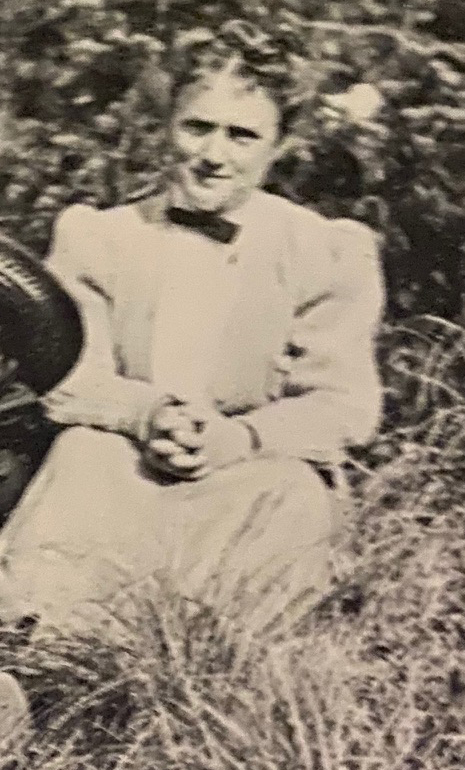 Garnet, Montana. Mrs. Adams. 7
Garnet, Montana. Mrs. Adams. 7
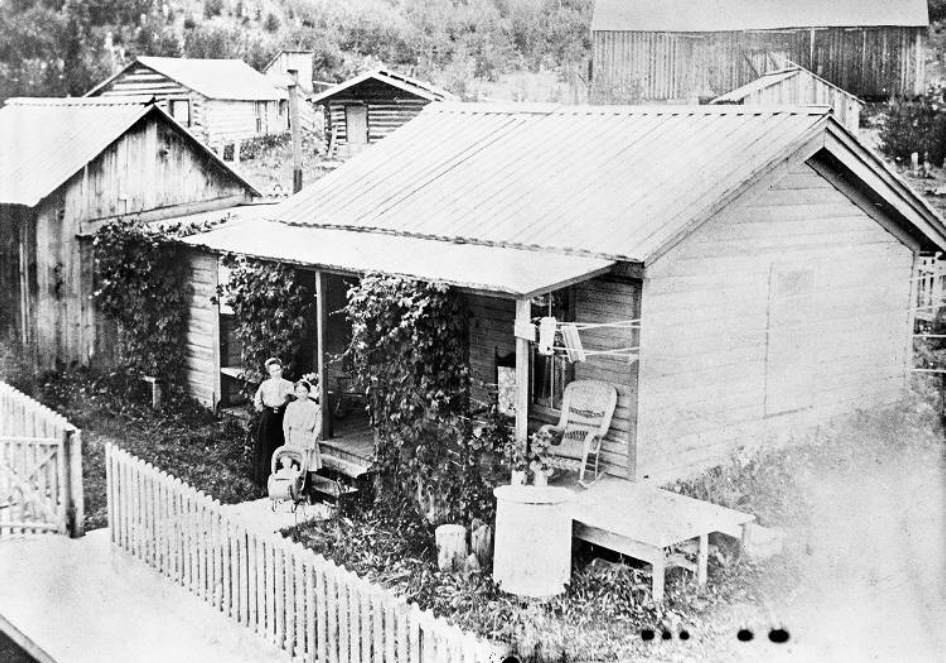 Garnet, Montana. The Adams house 1905.
Montana Memory
Garnet, Montana. The Adams house 1905.
Montana Memory
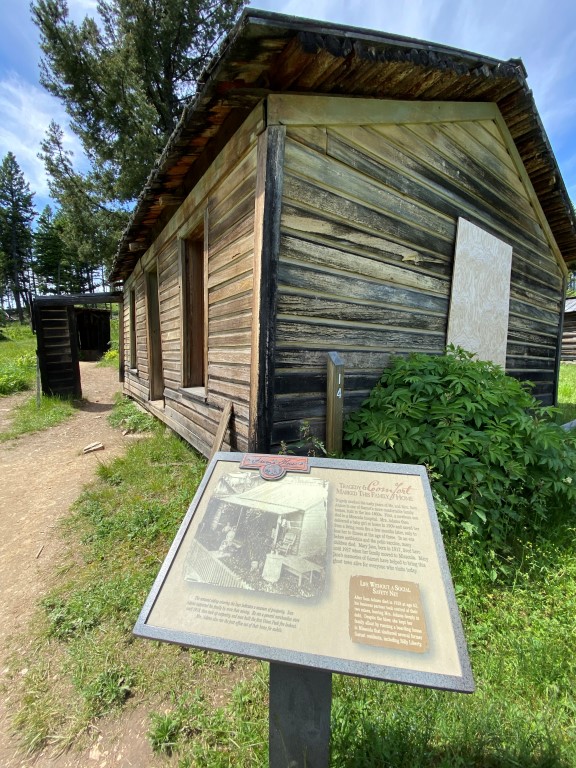 Garnet, Montana. The Adams house. P Marlin 2020.
Garnet, Montana. The Adams house. P Marlin 2020.
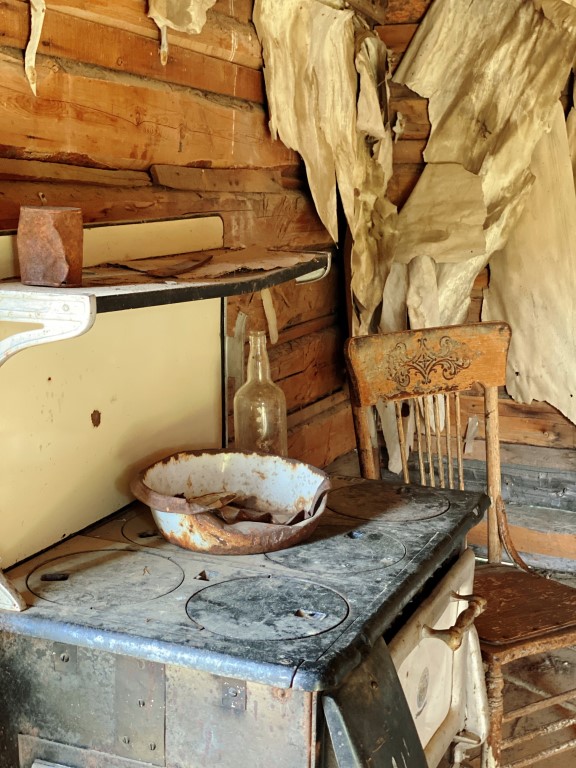 Garnet, Montana. Inside the Adams house. P Marlin 2020.
Garnet, Montana. Inside the Adams house. P Marlin 2020.
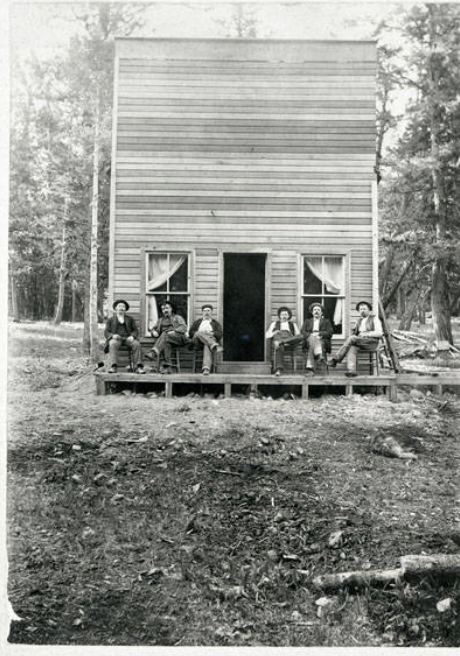 Garnet, Montana. Adams General Store which is no longer standing.
Montana Memory
Garnet, Montana. Adams General Store which is no longer standing.
Montana Memory
The Kohr House. John Kohr was a miner who originally settled in the small town of Coloma, adjacent to Garnet. In 1945 he worked as a miner in Garnet. It was during this time that he met Christine. Christine was born and raised just over the hill from Garnet in the farm lands of Potomac, Montana. The Kohr family lived in Garnet until the 1950s. They would return to Garnet to oversee John’s mining claims. John and Christine purchased a summer cabin in Garnet, located next to the Dahl house, which their children still visit.
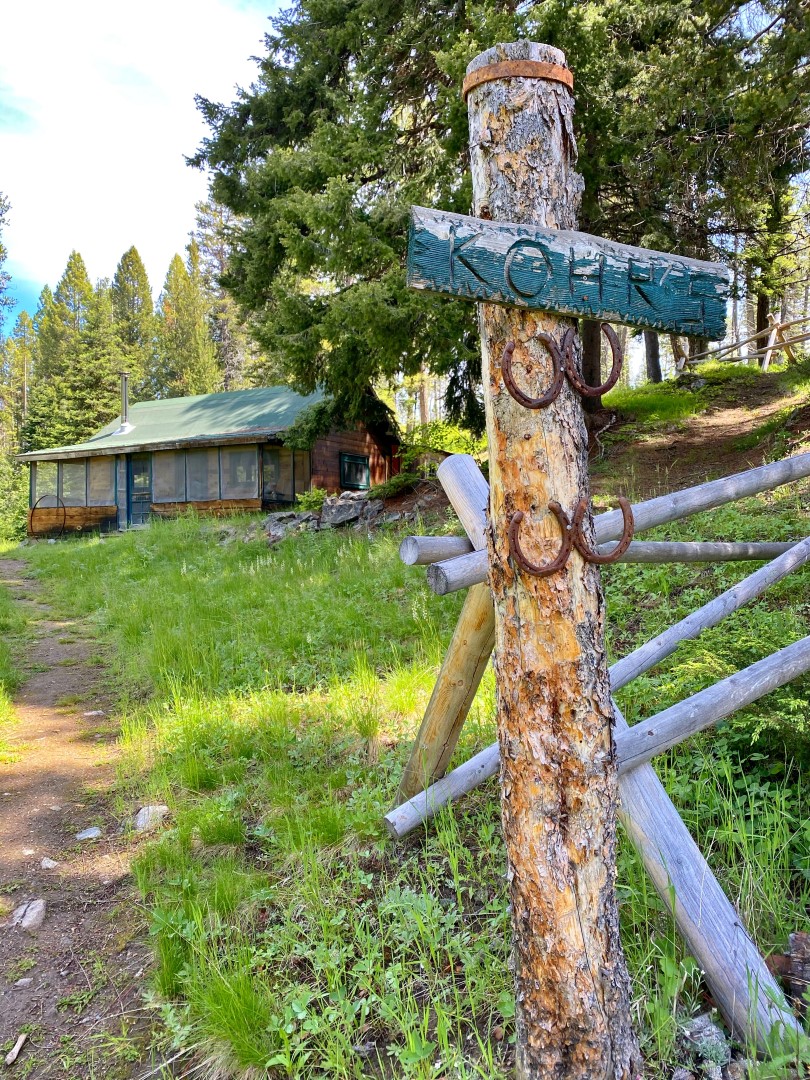 Garnet, Montana. The Kohr House. P Marlin 2020
Garnet, Montana. The Kohr House. P Marlin 2020
The Hanifen House. A 1- 1/2 story board and batten structure built in the early 1900's by Hugh Hanifen. He lived in the house until 1916. Mrs. Clearly, a school teacher, lived there until 1926.
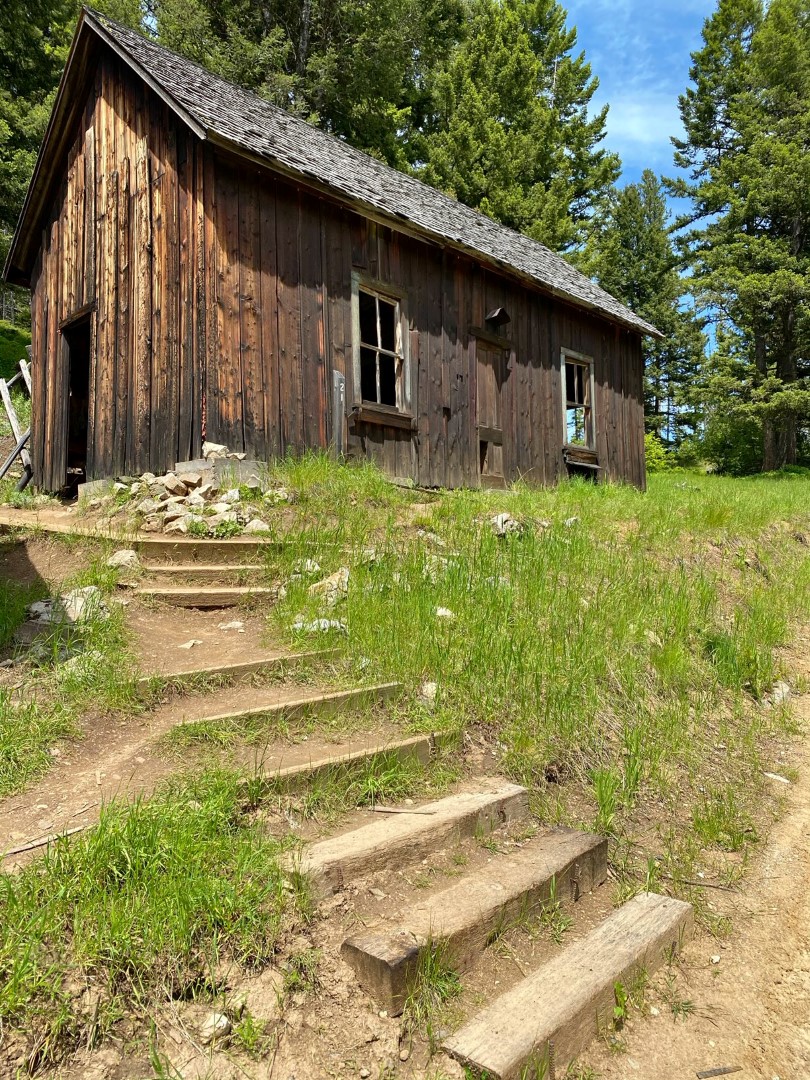 Garnet, Montana. The Hanifen House. P Marlin 2020
Garnet, Montana. The Hanifen House. P Marlin 2020
 Garnet, Montana. Inside the Hanifen House. P Marlin 2020
Garnet, Montana. Inside the Hanifen House. P Marlin 2020
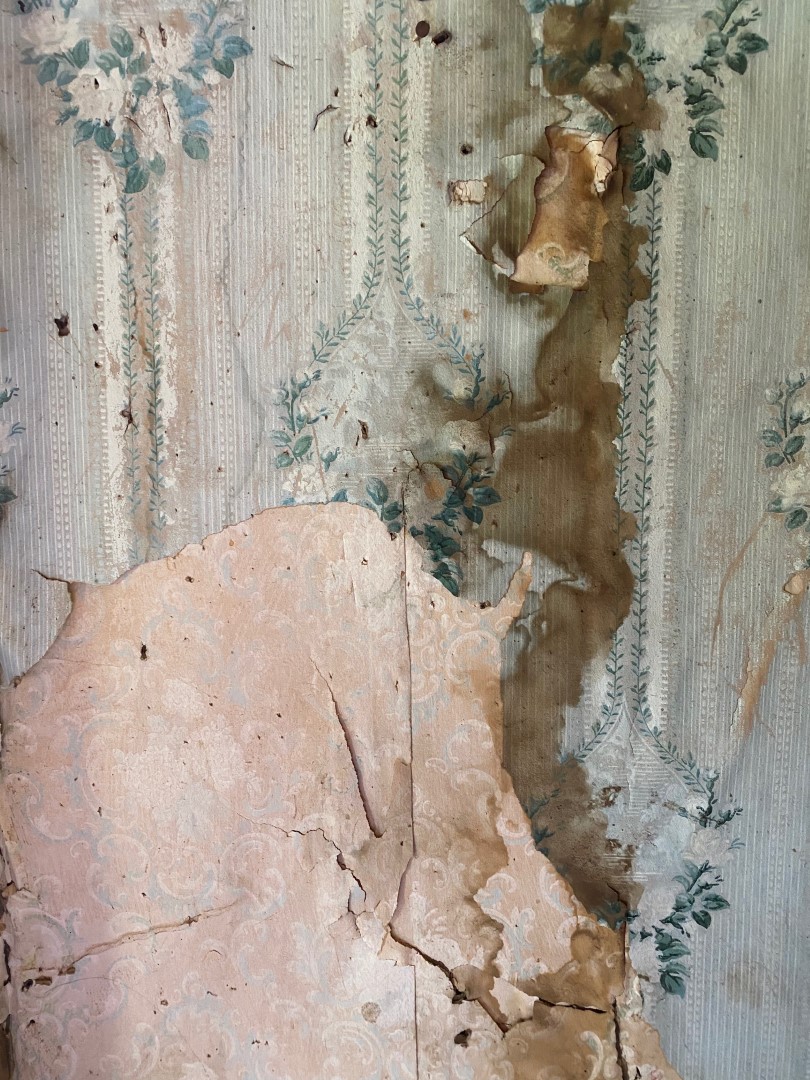 Garnet, Montana. Layers of wallpaper inside the Hanifen House. P Marlin 2020
Garnet, Montana. Layers of wallpaper inside the Hanifen House. P Marlin 2020
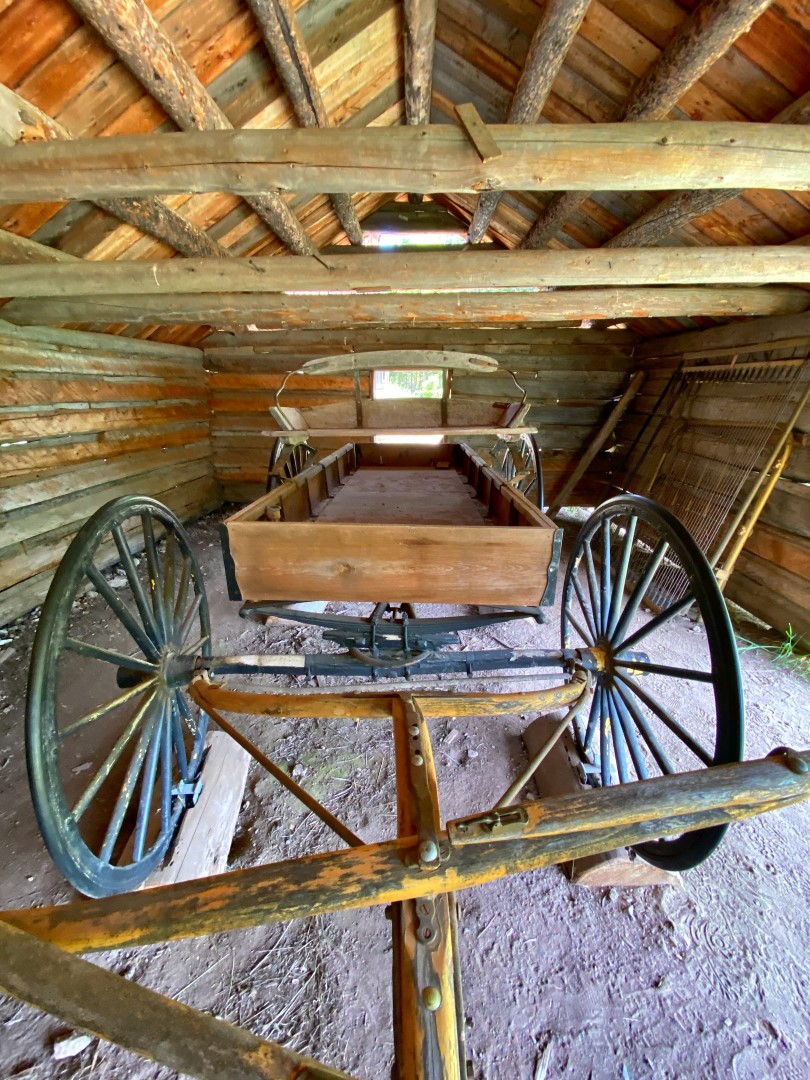 Garnet, Montana. The Hanifen House was located next to the livery shed. Once a cabin, Frank Davey altered the structure so he could store his coach inside. P Marlin 2020.
Garnet, Montana. The Hanifen House was located next to the livery shed. Once a cabin, Frank Davey altered the structure so he could store his coach inside. P Marlin 2020.
Located along Garnet Range Road on the drive to Garnet, the Sand Park Cemetery primarily served Coloma. Old wood markers stand for Tom Williams and William Ross (died 1898), William Hamilton (1905), William Scheehan (1906), and Frank Holmes (1914). According to an article in The Missoulian dated May 27, 2013, non-destructive sub surface testing indicated that when Garnet Range Road was built prior to World War II, a bulldozer cut through the middle of unmarked graves. Encountering skeletal remains and coffins, they were reburied near the same spot.
Frank Holmes was a quartz miner and saloon keeper in Garnet, Montana. Read Frank's story "What's a Name on a Grave?" at JSTOR.
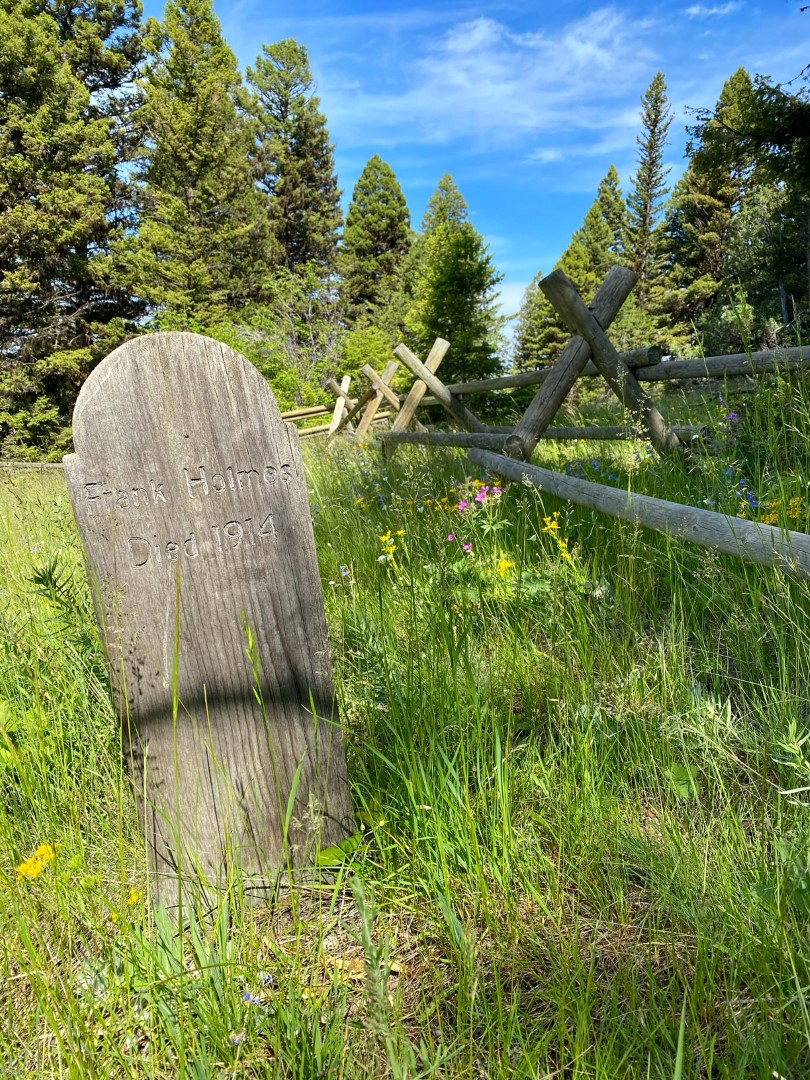 Sand Park Cemetery. Frank Holmes. P Marlin 2020.
Sand Park Cemetery. Frank Holmes. P Marlin 2020.
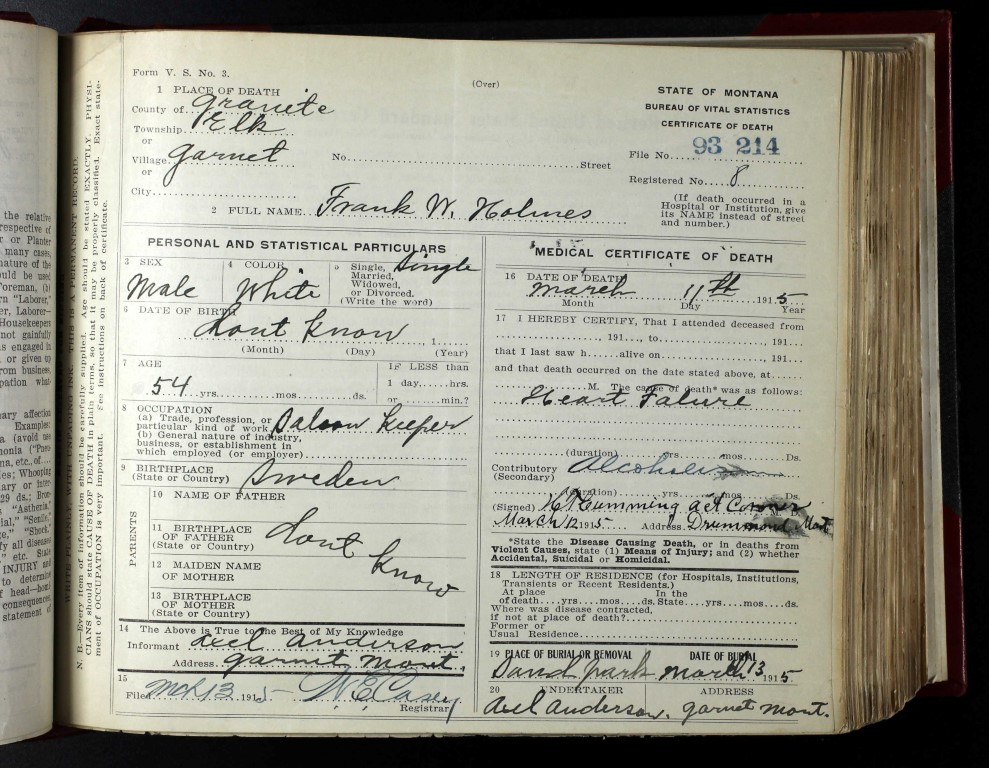 Sand Park Cemetery. Frank Holmes death record. Ancestry.
Sand Park Cemetery. Frank Holmes death record. Ancestry.
 Sand Park Cemetery. P Marlin 2020.
Sand Park Cemetery. P Marlin 2020.
 Sand Park Cemetery. P Marlin 2020.
Sand Park Cemetery. P Marlin 2020.
There is not a headstone, and not much is known of Frank Hamilton, however, his obituary indicates he is buried in this cemetery.
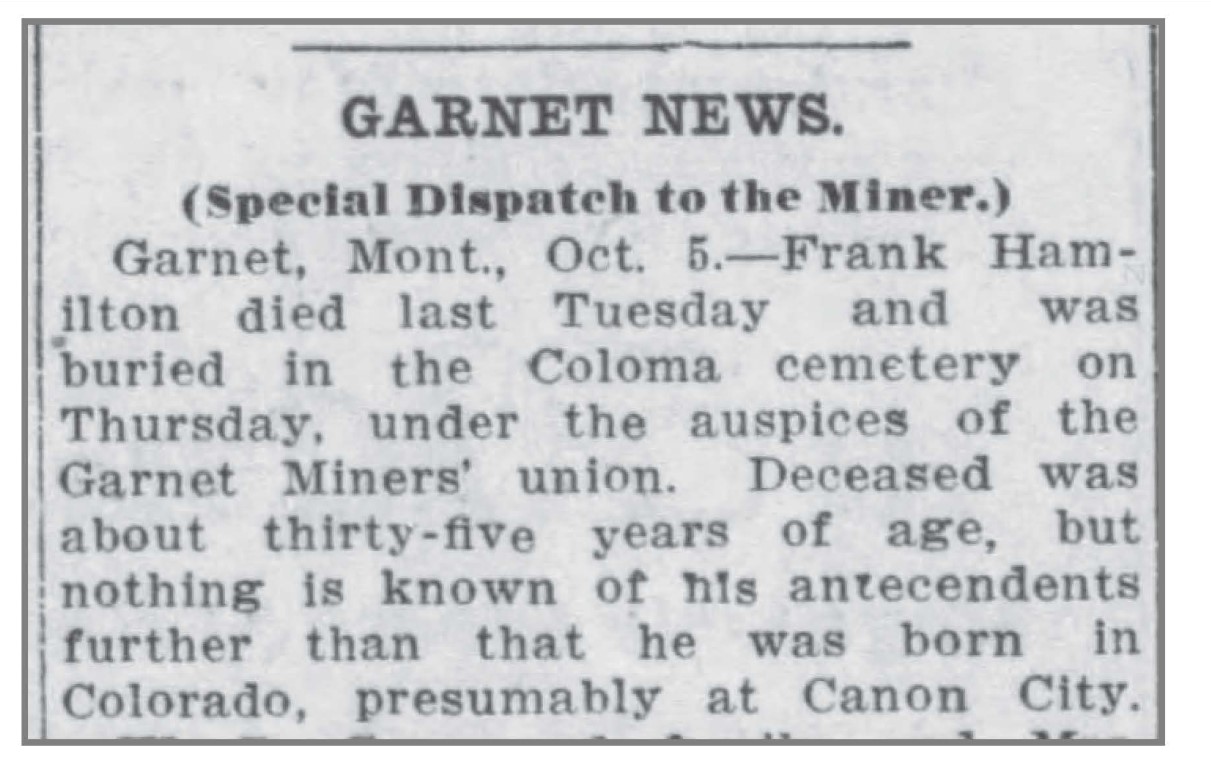 Sand Park Cemetery.
Sand Park Cemetery.
1 Montana Department of Environmental Quality
2 Cushman, Dan, 1964. Article, "Montana's Last Booming Gold Camp", Montana the Magazine of Western History, Pages 38-54. Published by the Montana Historical Society.
4 The Samuel and Lena Ritchey Family. Granite Co., Montana. Gen Web Files
5 Garnet Ghost Town Residents.
6 The J.K. Wells Family. Granite Co., Montana. Gen Web Files
7 Hammond, Helen. 1983. Garnet, MOntana's Last Gold Camp. Acme Press, Missoula, Montana.